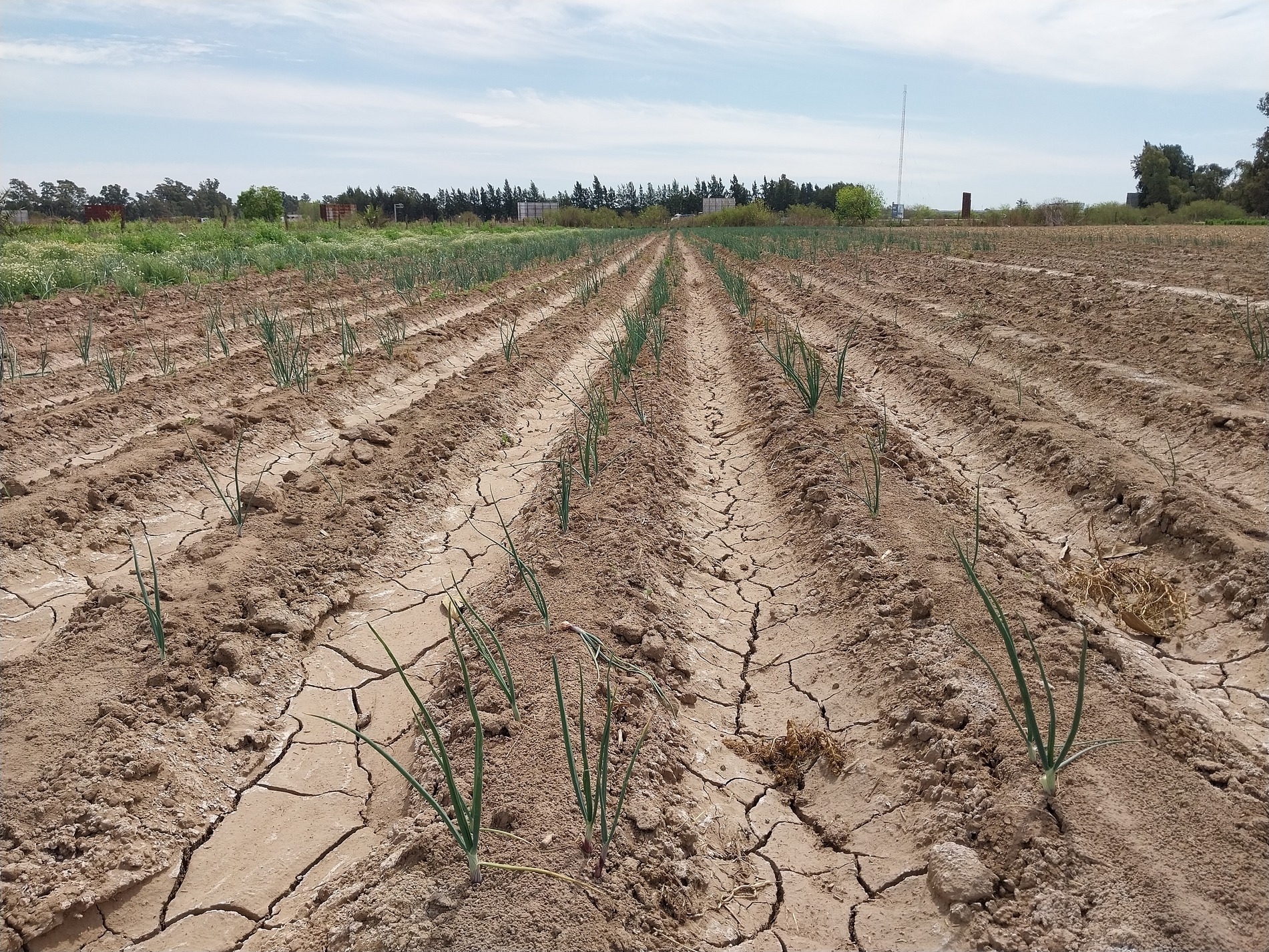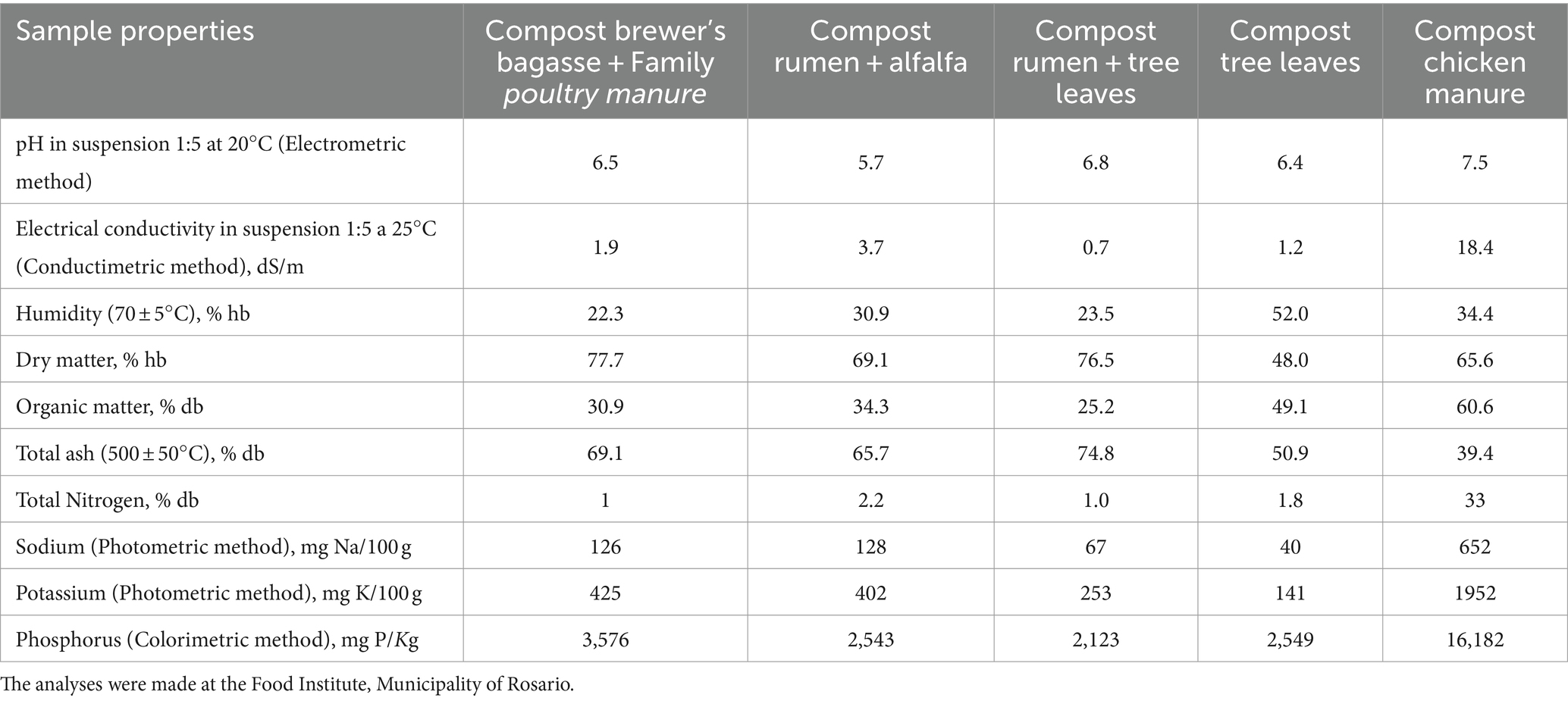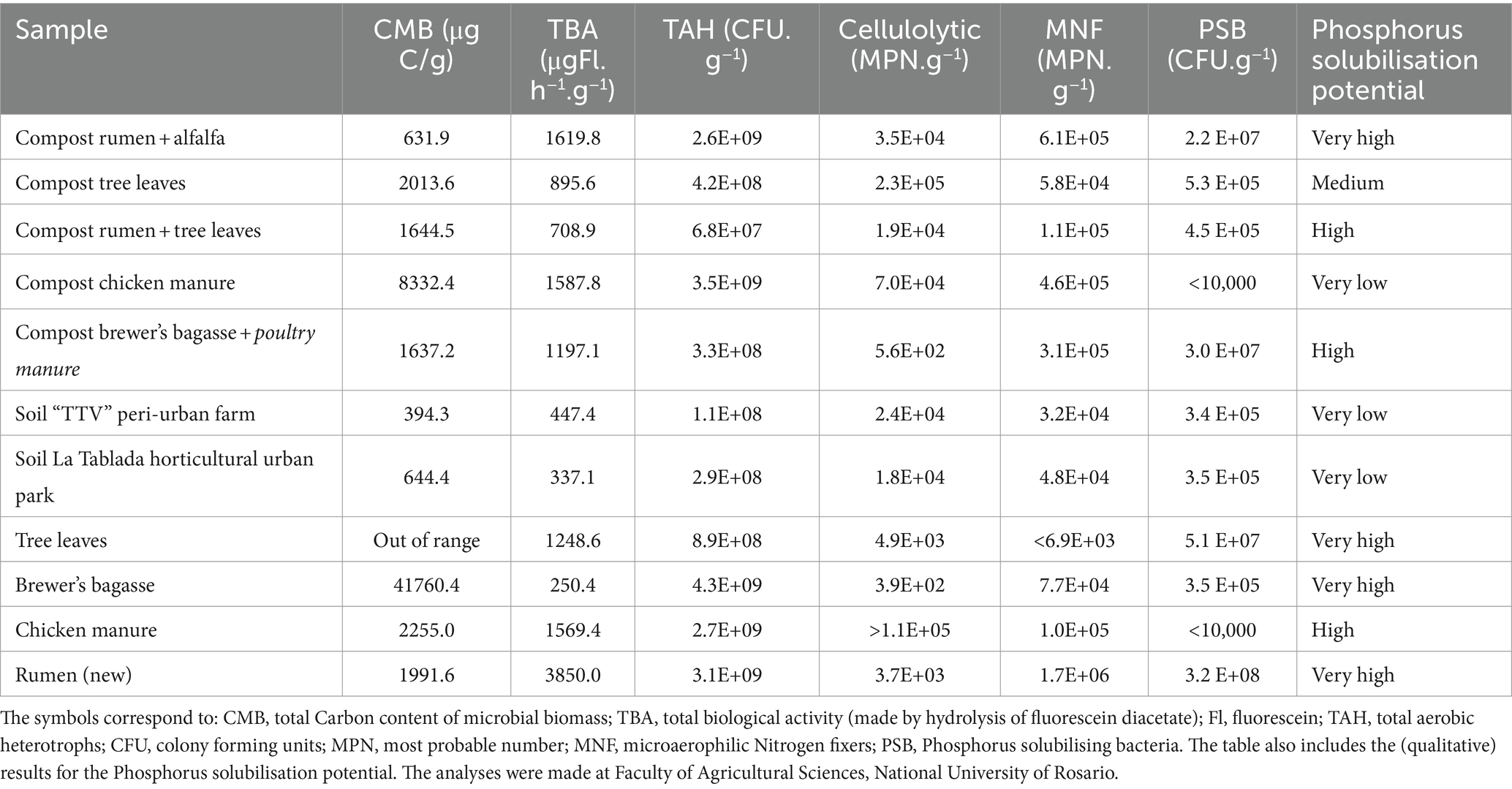- 1Programa Cinturón Verde Rosario, Secretaría de Desarrollo Económico, Municipalidad de Rosario, Rosario, Argentina
- 2Carrera de Ingeniería Agrónoma, Facultad de Ciencias Agrarias, Universidad Nacional de Rosario, Rosario, Argentina
- 3Instituto del Alimento, Secretaría de Salud Pública, Municipalidad de Rosario, Rosario, Argentina
- 4Instituto de Procesos Biotecnológicos y Químicos Rosario (CONICET – Universidad Nacional de Rosario), Rosario, Argentina
- 5Instituto de Física Rosario (CONICET – Universidad Nacional de Rosario), Rosario, Argentina
- 6Instituto Tecnológico de Diseño e Innovación, FCEIA, Universidad Nacional de Rosario, Rosario, Argentina
- 7Future Water Institute, University of Cape Town, Cape Town, South Africa
- 8Centre for Agroecology, Water & Resilience, Coventry University, Coventry, United Kingdom
Urban and peri-urban lands can be an important source of food production for localised and sustainable food systems, however, their soils can be of poor quality, degraded or damaged by anthropic activities, and little is known about their suitability or safety. This paper aims to contribute to this knowledge gap by assessing the soil remediation capacity and qualities of different types of compost made from urban and peri-urban organic wastes for agroecological food production. Prepared over the course of 2021, and used in 2022 for food growing, five different composts were observed and analysed, in two different farms in the city of Rosario, Argentina. Four raw materials generated largely by local industries were used to make the composts: chicken manure, rumen (cow’s stomachs), brewer’s bagasse (byproducts of the beer industry) and urban leaves collected from the municipality waste collection. These were mixed in different proportions (all reaching the 20–30 C/N ratio, typical of quality compost) to produce viable growing substrates where radishes and lettuces were grown. The aim of the study was to assess the possibility, quality and limitations to use locally available organic inputs for soil fertility management in agroecological farming, in the context of urbanisation and to assess pathways to develop closed-cycle agroecological agriculture at metropolitan level. Natural manure substrates (raw and composted) were analysed, as well as crops grown and fertilised with each of the substrates. The attributes and limiting factors of each substrate and their response to local soil conditions were compared and physicochemical, biochemical, and microbiological analyses were performed, including among others, the study of microbial biomass, biological activity, biophytotoxicity, pH, aerobic heterotrophs, nitrogen fixation, and the presence of antibiotics, agrochemicals and heavy metals. The results of the analyses show that all the composted materials improved the physical, chemical and biological properties. However, in some cases, pollutants were present even after composting. Analysis carried out on the vegetables generally indicate undetectable levels or levels below the admissible limits, demonstrating the filtering capacity of the different composts and the soil.
1 Introduction: soil regeneration and agroecological policies in the Rosario city region
In recent years, the protection of healthy soils has risen in the agenda of national and supranational institutions (such as the EU and the UN within the Sustainable Development Goals) that have undertaken the commitment to stop “net land take” by 2050. Nonetheless, processes of “no net land take” means that land development and soil destruction will still happen insofar as soils are recreated or regenerated elsewhere through de-sealing and returning land to agricultural use or nature conservation. These trends, as well as the reality of large populations relying on food produced in periurban conditions, urge us to learn more about how to remediate damaged urban soils and improve their fertility in safe and sustainable ways.
The city of Rosario is an interesting context where to explore these questions, as it has an extensive presence of urban agriculture on marginal and damaged lands and it has engaged with the challenge to regenerate them. Rosario, as many cities, has also a significant amount of sources of organic waste generation with the capacity to be compostable and to be used as an input for the production of food in urban and peri-urban areas. The question is whether these materials have the necessary quality to be used as compost for agroecological production –which is the production of healthy food based through farming practices that simultaneously care for people, soils and the planet—without leading to the accumulation of urban pollutants, pharmaceuticals and pesticides (which are often present in these wastes) within soils, plants and food. The answer to this question is the one that guides the present work.
Working within the framework of agroecology, this paper offers preliminary results from field and laboratory analyses, by comparing different ways to amend urban soils for food production mainly from urban and periurban organic waste. The research was carried out within the context of an interdisciplinary research project bringing civil society, academics, policy makers and practitioners together.
An agroecological approach to soil amendment means not only an intention to work with nature and in respect of the multiplicity of forms of life relying on healthy soils for their survival, but also the appreciation of multiple knowledge producers that engage in soil care through agroecological food production and a commitment to maintaining dignified and supported livelihoods.
With a commitment to resource conservation and regeneration, agroecological production is also usually characterised by closed-loop cycles of agricultural inputs, for example returning animal manure, crops waste or tree pruning to the soil, once composted, to regenerate soil fertility. However, the urban location of many new agroecological farms means that most of them do not have enough space for engaging in all these different farming systems (pastures, forestry, animal rearing and horticulture). Urban and periurban farms, if willing to grow with agroecological methods, often have to integrate on-farm organic waste (i.e., animal manure, if available), with the use of local urban and periurban organic wastes and the use of green manures. Our work deals with the challenge to build close-loop agroecological farming systems beyond the farm gates, but within the metropolitan scale.
The aim of this study is to analyse the quality of a selection of compostable organic wastes generated in abundance in the city of Rosario, Argentina and adjacent regions, which can constitute an important source of input for agroecological food producers to remediate soils degraded by urbanisation and decades of agro-industrial agricultural production (Urricariet and Lavado, 1999).
The Pampean region, to which the city of Rosario belongs, used to have very fertile soils due to its natural conditions. According to Rubio et al. (2019) in their publication The Soil of Argentina, they are the most valuable and fertile in the country, with a very dark colour and very good drainage. One of the components that refers to the fertility of soils is their percentage of organic matter. It is assessed (Wilson, 2017) that to be considered ideal, agricultural soil should have close to 5% of organic matter.
The intensive production model that has been practiced in Argentina and particularly in the Pampean region since the second half of the 20th century, has led to the deterioration of the physical, chemical and biological properties of soils (Urricariet and Lavado, 1999). Intensive production refers to a range of productivist practices, generally conventional agriculture, carried out with the aid of mechanical tools (plough), synthetic fertilisers and pesticides, which speed up the short-term fertility of soils and biocide of ‘pests’, but at the expenses of a rich and diverse set of microbiological relations in the soil. These include mycorrhizal networks that enable the exchange of nutrients among plants and fungi, and that sustain soil life. Also, the intensive and continuous use of machinery, pesticides and chemical fertilisers, brought about a decrease in the depth of the superficial horizon, a reduction in the content of organic matter and the porosity of the soil and a continued exploitation of the soil without nutrient replenishment (see for example, Wilson, 2017).
In the Rosario region, there is a large amount of urban and peri-urban land with degraded soils that have been exhausted in their capacity for agronomic use, due to the intensive and continuous use, without nutrient replenishment.
In studies conducted by the Municipality of Rosario (Mazzuca et al., 2008) at the time of mapping the soils of spaces available and used for urban agriculture, a whole range of agronomic limitations were identified in urban and peri-urban areas, in addition to the exhaustion from intensive agriculture. Many of these lands were marginal, located at railroad sides or low sides of watercourses, with drainage problems in flat soils. The history of industrial activities was also evident, with many of these lands being used to dump byproducts of the construction industry, such as clay from brick kilns and landfill soils with construction debris.
The city of Rosario—as many cities in the world—offers a wide variety of sources of biological raw materials for composting and closing material and energy cycles, generated by industry and agricultural activity in its peri-urban area.
In this research, the quality of different raw materials and composts made with materials from agro-industrial waste (e.g., meat processing, craft beer, poultry) and leaves from urban trees has been evaluated, in order to test their attributes and limitations for use as a productive input in the production of agroecological vegetables. In particular, in order to produce quality compost, the materials used must have a Carbon/Nitrogen (C/N) ratio in the range of 20 to 30. We assessed the following combinations of composts or mixes directly with a raw material (as in the case of tree leaves): 50% brewer’s bagasse +50% family poultry manure; 70% public tree leaves +30% rumen (cow’s stomach); 100% public tree leaves; 70% chicken manure +30% alfalfa; 70% rumen +30% alfalfa. These different combinations were measured against a reference soil taken from the farm, without any amendment.
It is important for agroecological food production to test the suitability of these substrates, in addition to the nutrient supply to the soil and crops, to determine if they are free (or below a pre-established limit) of contaminants that could affect the quality of the obtained food. This research work is part of two projects: the JPI Urban Europe and Belmont Forum funded project “Urbanising in place,” funded under the Sustainable Urban Global Initiative (SUGI) call Food-water-energy nexus which has investigated the relationship between soil, water and food, and the Future Earth “Pegasus 3” initiative funded project “SOIL NEXUS: Building policy tools for water and waste-based soil remediation”,1 which is deepening its analysis in the healthy soil component.
During the year 2021, the process of the five composts produced from the aforementioned combinations of substrates has been elaborated and monitored in the field. In 2022, the field behaviour of these materials has been evaluated, based on the productive response of lettuce (Lactuca sativa) and radish (Raphanus sativus) to the different composts, compared to a reference control. They were also subjected to laboratory, biophysical-chemical and antibiotic and pesticide residue analyses. The treated soils, where the productive trials were carried out, were evaluated in an urban horticultural garden, Parque Huerta La Tablada and in a periurban farm (called Trabajo en Tierra Viva, TTV). Our evaluation assessed compost and soil components, such as carbon content of the microbial biomass, pH, total aerobic heterotrophs, nitrogen fixation by micro-aerophiles, P solubility potential, nitrogen, Na, P and total K, biological activity, bio-phytotoxicity in relation to root elongation, germination index, microbiological analysis of faecal coliforms, presence of antibiotics, pesticides and heavy metals (Cr, Ni, Cu, Zn, As, Cd, Hg, Pb). In addition, nutritional content analyses were carried out on the lettuces and radishes obtained in the field trials. The water used in Rosario city and for irrigation of the trial production areas was also analysed.
In the city of Rosario, a process of agroecological food production has been in development since the 1990s and consolidated since 2002, with the creation of the Urban Agriculture Program of the Municipality of Rosario, aimed at including the population in vulnerable conditions in a Social Economy circuit (that receives social and economic support), giving value to marginal spaces and recovering degraded lands. This resulted in the establishment of the Vegetable Garden Parks as an expression of the integration of Urban Agriculture in city planning (Lattuca, 2011). This process was supported by the establishment of the Green-belt Project in 2016, which represented a significant step in advancing an agroecology approach by adding value to the work of small family farmers, who initially produced food for their neighbours, before expanding to other parts of the city. This ultimately meant also regenerating degraded lands, a by-product of the agro-industrial model of intensive production based on chemical inputs (Battiston et al., 2017) which has affected the area for several decades. This Green-belt Project supports the transition of producers from chemical input technologies to agroecological production systems based on promoting soil biology, biodiversity and biological inputs.
A central theme in these programs has been the protection of land spaces through Land Use Planning regulations and the care of their health for food production. The restoration, protection and reactivation of urban and periurban agricultural soils has been recognised in Rosario as key to building a resilient city, incorporating the agroecological vision in a number of local public policies. Maintaining healthy, sustainable and fertile soils is a key tool within the Local Climate Action plan for 2030. Rosario has included the use of land for food production in its city planning, both in the urban and periurban areas under the concept of green infrastructure, in the Cuidar (Take care) Plan and in the Local Food Plan.
A key aspect in the regeneration of degraded soils has been the production and use of compost made with a range of organic materials sourced across the city.
The application of compost for improving soil quality is an ancient technique (Figure 1). It improves soil properties, water use and soil productivity, as for example is well illustrated in a review article by Adugna (2016).
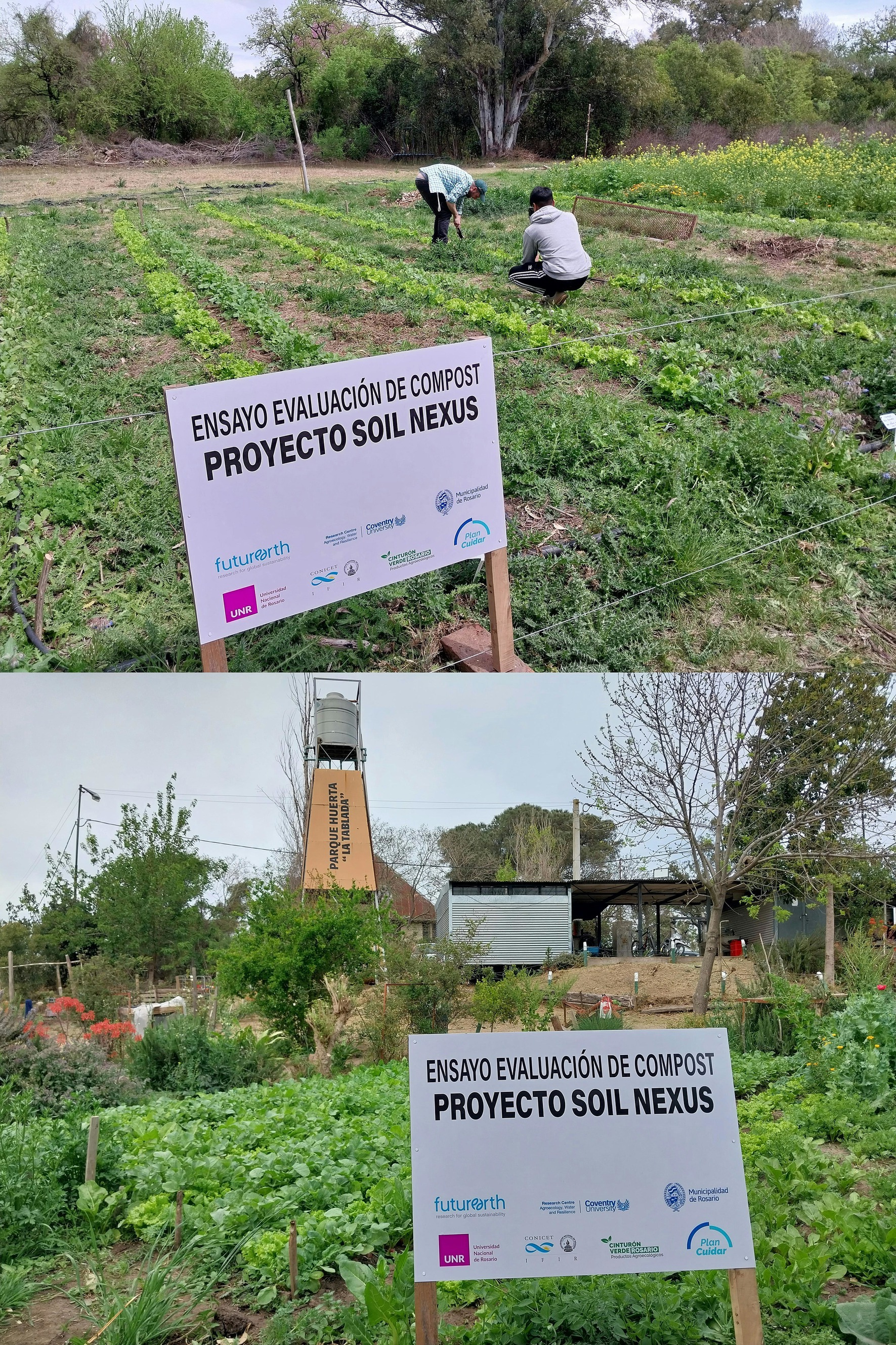
Figure 1. Essays of the compost evaluation were performed at the urban agroecological park La Tablada (top), and at the periurban farm Trabajo en Tierra Vida (TTV) (bottom), both at Rosario city, Argentina.
Kranz et al. (2020) provided an assessment of the possibilities to enhance urban soils used for agriculture with the introduction of compost, resulting in the adjustment of soil physical properties, nutrient dynamics, and vegetation establishment.
Soil microorganisms play a fundamental role in the decomposition of organic matter by transforming nutrients into forms that are easily assimilated by the plant. It is important to have a diverse population of microorganisms with the ability to process a variety of organic compounds into plant nutrients (Zhang et al., 2012; Mobilian and Craft, 2022). This mineralisation process is directly associated with the size of the microbial populations and their activity (Toresani et al., 2012). This principle was also enunciated in the 19th century as the humus theory by Albrech Thaër, who stated that humus was the only substance in the soil that nourished plants, in addition to water (Robin, 2013).
According to the theory of trophobiosis, enunciated by Francis Chaboussou in 1987, the organic defences of plants are a function of providing them with balanced organic nutrition. This prevents the accumulation of simple nutritive substances in the sap or cytoplasm (such as amino acids and free sugars). That would be available as food for heterotrophs such as insects, bacteria and fungi. It is argued that plants are attacked by pests or become sick when the plant becomes unbalanced or stressed, due to poor nutrition, chemical fertilisation, use of agrochemicals, drought, flooding or ageing, triggering mechanisms for the release of these substances into the sap (Restrepo, 1994).
As background, in 2010, researchers from the Faculty of Agricultural Sciences of the National University of Rosario (Toresani et al., 2012), had investigated the horticultural park El Bosque in Rosario, installed on a degraded soil (anthropised, filled with soil from excavation works), located on the banks of the Ludueña stream. They compared this soil, taken as a control or reference, with another soil modified with agro-ecological practices. They determined that “the microbial activity evaluated through its carbon content and its total biological activity presented higher values than those registered in the soils taken as reference (40 and 60% respectively). After 12 months in the environments enriched with fresh organic residues and/or compost, a notable increase in organic matter (OM) content was observed, and nitrate and assimilable phosphorus values quadrupled on the surface” (Toresani et al., 2012).
The current prevailing situation of land in the Rosario Green-belt is of degraded soil, due to intense agricultural use (monocultures plus intensive use of agrochemicals), as shown in Figure 2. A key challenge for the conversion of large portion of depleted soils into agroecological farms is the ability to provide sufficient, high quality and regular organic matter as substrates.
The identification of a number of urban sources for organic waste, such as byproducts of the beer industry (fermented barley), the bedding of poultry farms (chicken manure), the rumen of cows (cow’s stomachs) from the meat processing plants, clippings and urban green waste from municipal parks or green waste collection, appeared as an easily obtainable waste, whose re-use for soil improvement could also have the benefit of reducing the waste going to landfill. While the re-use of urban organic waste for food production is claimed as a win-win by several policy sectors, little research however has been carried out on how these wastes can be used in agroecological practices, in which proportions they could be used effectively, and whether they carry the risk of accumulating noxious pharmaceuticals used in the farm industry, or heavy metals accumulated on green waste in urban polluted areas.
Through the SOIL NEXUS project (detailed above), we have teamed up with a transdisciplinary and international community to explore agroecological practices of soil care and to discuss how lab science can team up with soil care practitioners and offer suggestion for effective and safe urban soil amendment.
In this paper, we present the preliminary results of our investigation of different compost mixes based on analytical determinations carried out in different laboratories, as well as in field studies at “La Tablada” urban agroecological park and at the “Trabajo en Tierra Viva” (TTV) periurban farm, both in Rosario city, Argentina, as illustrated in Figure 1.
2 Materials and methods
In order to evaluate the suitability of the resulting compost as a valid input for the production of organic food, several analyses were carried out on the soil, compost, water and plant matters in different laboratories at the public National Universities of Rosario and La Plata, at the Research Centre of CONICET, and at a Laboratory of the Municipality of Rosario. Different methodologies were used for the analysis of vegetables, soils and composts, which included an analysis of:
- heavy metals using Atomic Absorption Spectrophotometry,
- salts and compounds by complexometric Titulometry,
- redox and colorimetric techniques with UV Spectrophotometer,
- bacterial count by plate culture,
- agrochemicals and antibiotics using High Performance Liquid Chromatogrphy and Gas Chromatography
- detection of parasites by microscopic observation.
- enzymatic digestion for fibre
- Soxhlet apparatus for fat
- Kjelhdahl method for Nitrogen content (protein), among others, were used to determine the nutritional qualities of vegetables.
Radish and lettuce crops were also utilised to gauge how well the various composted substrates under study performed in terms of yield.
In the current study, we took into account the following resources and human input: (a) soil from a horticultural park (La Tablada) and a periurban farm (TTV); (b) vegetables (lettuce and radish) to be used as a test of the effectiveness in growing under different compost supplementation to the soils; (c) the farmers of urban and periurban farms; (d) irrigation and (e) compostable raw materials: tree urban leaves, cow’s rumen, chicken manure and (malt) brewer’s bagasse.
The samples of materials used to make the compost are representative of the waste generated in the city of Rosario: waste from the brewing industry, meat from processing industry, poultry farming and urban trees.
The soils on which the trials were conducted (La Tablada and TTV) are representative of the productive spaces where urban and periurban agriculture is practiced in Rosario. In addition, the trials were conducted with 2 replications in both sites.
2.1 Compost development and productive essays
2.1.1 Compost development
The trials of the different composts have been carried out in the productive spaces of producers (Mrs Cocccito and Chirileison) in the Green Belt of Rosario (Figure 3). The composting method used is called pile composting. It is a type of aerobic compost, rather hot since it increases the temperature (approximately to 70°C) in its decomposition. It consists of assembling a mountain with the input substrates. An adequate mixture of raw materials must be maintained to ensure good decomposition. The recommended ratio is that for each part of fresh material (rich in Nitrogen) there should be 30 parts of dry material (rich in Carbon). The base is approximately 1 m x 1 m. To ensure aeration, a post is planted in the centre (which is removed periodically and functions as a chimney). The height, if possible, should be greater than one metre to ensure sufficient mass to raise the decomposition temperature. For the process to be completed, it is necessary that the compost has a balanced humidity.
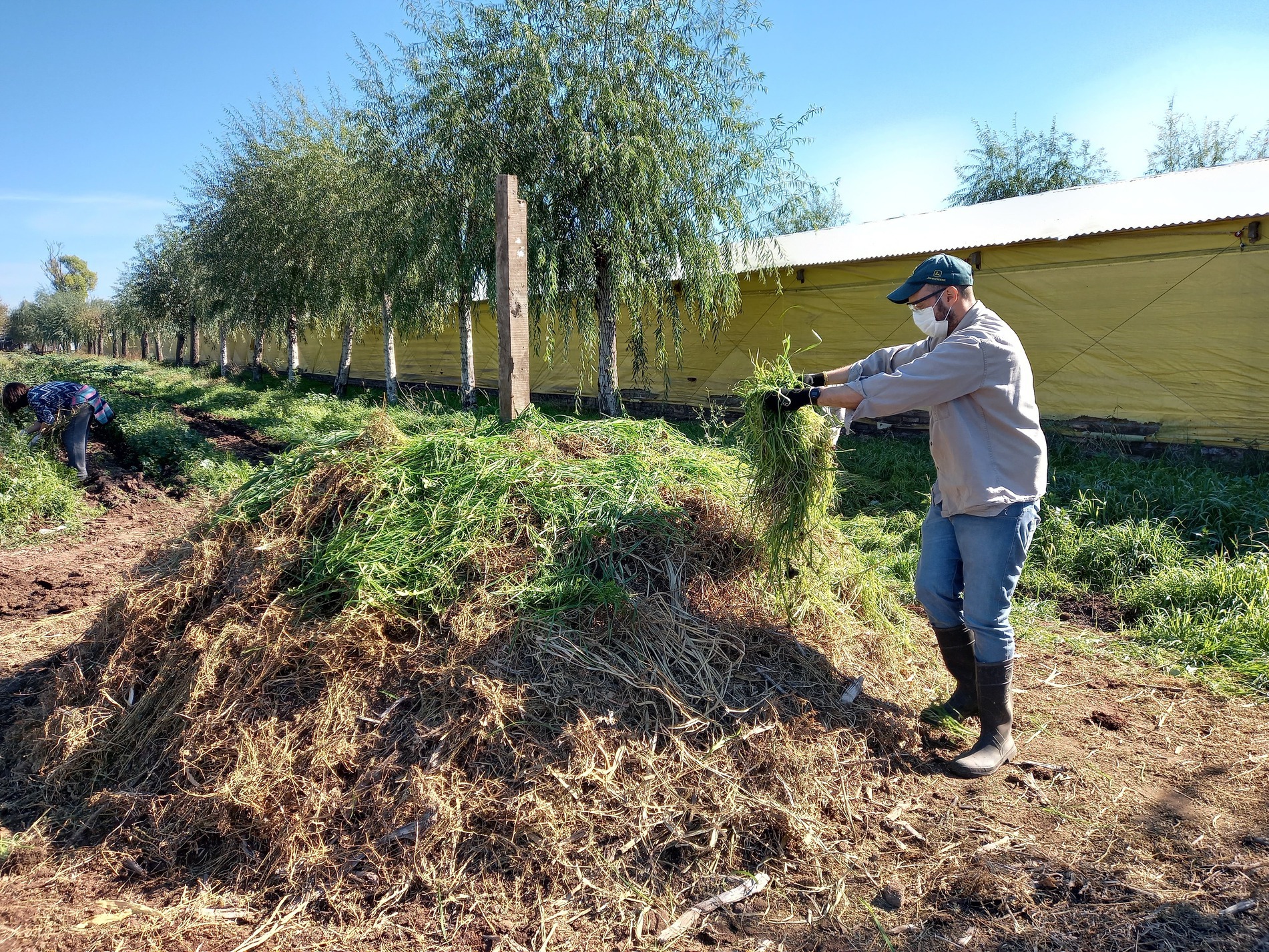
Figure 3. Compost pile based on chicken manure and alfalfa on the farm of the farmer Coccito at the Rosario Greenbelt.
The different mixtures were designed according to the materials available or accessible to the farmers. The recommendations of the Farmer’s composting manual (Román et al., 2013) and Productive group gardening manual (Urban Agriculture Program Rosario, 2003) were followed.
As an observation, during composting, rainfall was scarce, a situation that delayed the process. Also, the producer Coccito’s farm, where the compost was made from chicken litter, produces in a conventional way (based on chemical inputs), the production of chickens for meat in confinement, as well as extensive horticultural and cereal productions.
The respective composts shown in Figure 3, have been monitored in their decomposition process in relation to temperature, pH and humidity.
2.1.2 Development of production trials
The trials were carried out on the farm of the Cooperativa de trabajo TTV (Trabajo en tierra viva) linked to the Rosario Green Belt Programme and in the La Tablada vegetable garden park linked to the Urban Agriculture Programme. Both programmes belong to the Municipality of Rosario.
Both sites were prepared for vegetable growing in a similar manner (see Figure 4) by using a power tiller, which uses mechanical activity in the first 15 to 20 cm of soil to disrupt and crumble its natural structure (Figure 4, Top-left). While this method is likely to increase the oxidation of organic matter, it has the negative effect of disrupting the capillarity and connectivity of the pore space. However, it is an effective method for the control of unwanted weeds and for the correct preparation of the planting bed, providing a favourable environment for a correct contact of the seed or plant with the soil and the availability of nutrients.
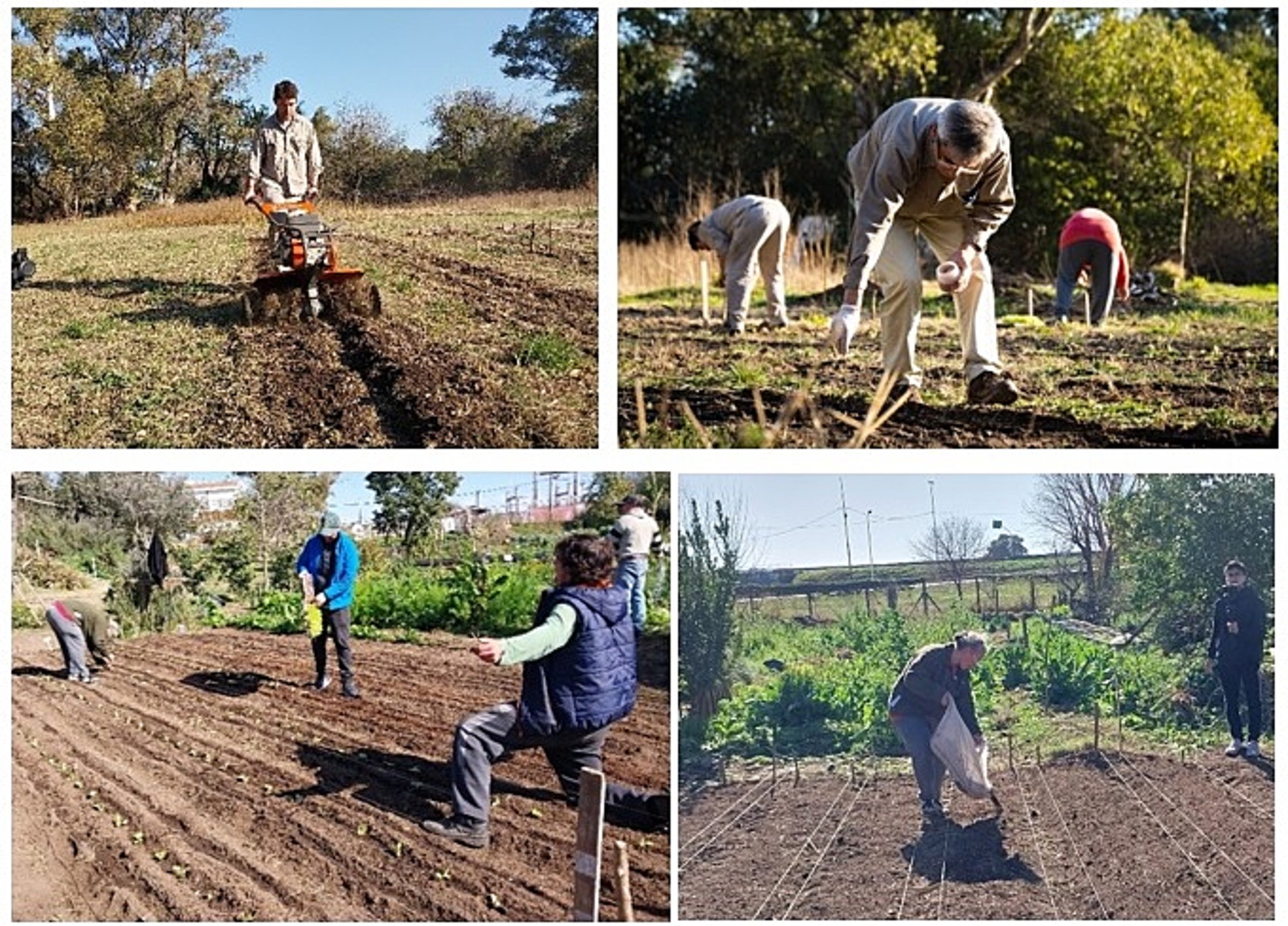
Figure 4. Top-left: Soil preparation with a moto-triller at “Trabajo en Tierra Viva” (TTV) periurban farm; Top-right: Radish sowing at the TTV periurban farm and Bottom-left and Bottom right: Details of the compost application on the treated soils.
Planting and transplanting (Figure 4, Top-right) were carried out on the same date for both sites, applying the same doses of compost for all treatments, once the plots were rototilled, before planting (Figure 4, Bottom-left and Bottom-right). No fertilisation with chemical synthesis substances, herbicides, insecticides and/or fungicides, nematicides or other soil sterilisation techniques was used (Figure 5). Previously, both sites were used for vegetable production, but no chemicals were being used prior to the study. In both locations and for all growing cycles, the radish crop was begun by planting controlled seeds and the lettuce crop was started by transplanting seedlings (procured from a conventional non-agroecological supplier, as producers usually do) to the chosen location. The idea was to reproduce the situation that it is most common in the use of seeds and transplanting seedlings.

Figure 5. Details of the placement in the soil of the lettuce and radish at periurban farm TTV and of the irrigation system.
The vegetables were planted in rows, in five plots of land measuring 10 × 0.50 m separated by 0.75 m as shown in Figure 5. Each one was fertilised with a specific compost. The following compost combinations were evaluated (1) 50% beer bagasse +50% family agroecological poultry manure; (2) 70% leaves from public trees +30% rumen (bovine cow stomach); (3) 100% leaves from public trees; (4) 70% chicken manure +30% alfalfa; (5) 70% rumen +30% alfalfa. A sixth plot was selected as reference, without addition of compost.
The horticultural park La Tablada irrigation system used spray watering and in-furrow. The drip irrigation technique was used in the TTV periurban farm, in an effort to keep the humidity around the field’s capacity (Figure 5). The main source of water supply during the research was irrigation because rainfall was less than the historical average. This ensured that the crops had the necessary water for their growth. Measurements of the water’s quality were made, taking into account factors like pH and electrical conductivity, among others.
The soils of La Tablada horticultural garden and the TTV periurban farm, were fertilised with different compost variants, using the different compost materials detailed above. A dose of 4 Kg/m2 with a total of 20 Kg of compost was applied to each tested plot. To ensure the successful production of vegetables and to analyse them, two trials were carried out (in the two distinct sites), with the results from the urban farm TTV being chosen at the conclusion of the crop, since it was considered that given its short history of agroecological use and greater need of fertilisation,2 the place shows more appropriate conditions to evaluate the parameters to be analysed in the present work. An untreated reference soil was selected in each horticultural and periurban farms. The time period of the preparation of soil and of seedling was the end of winter and spring of the southern hemisphere (September–November 2022).
Figure 6 shows the lettuce and radish harvested at the end of the food production period, where differences in each of these vegetables can be observed, as detailed in Table 1.
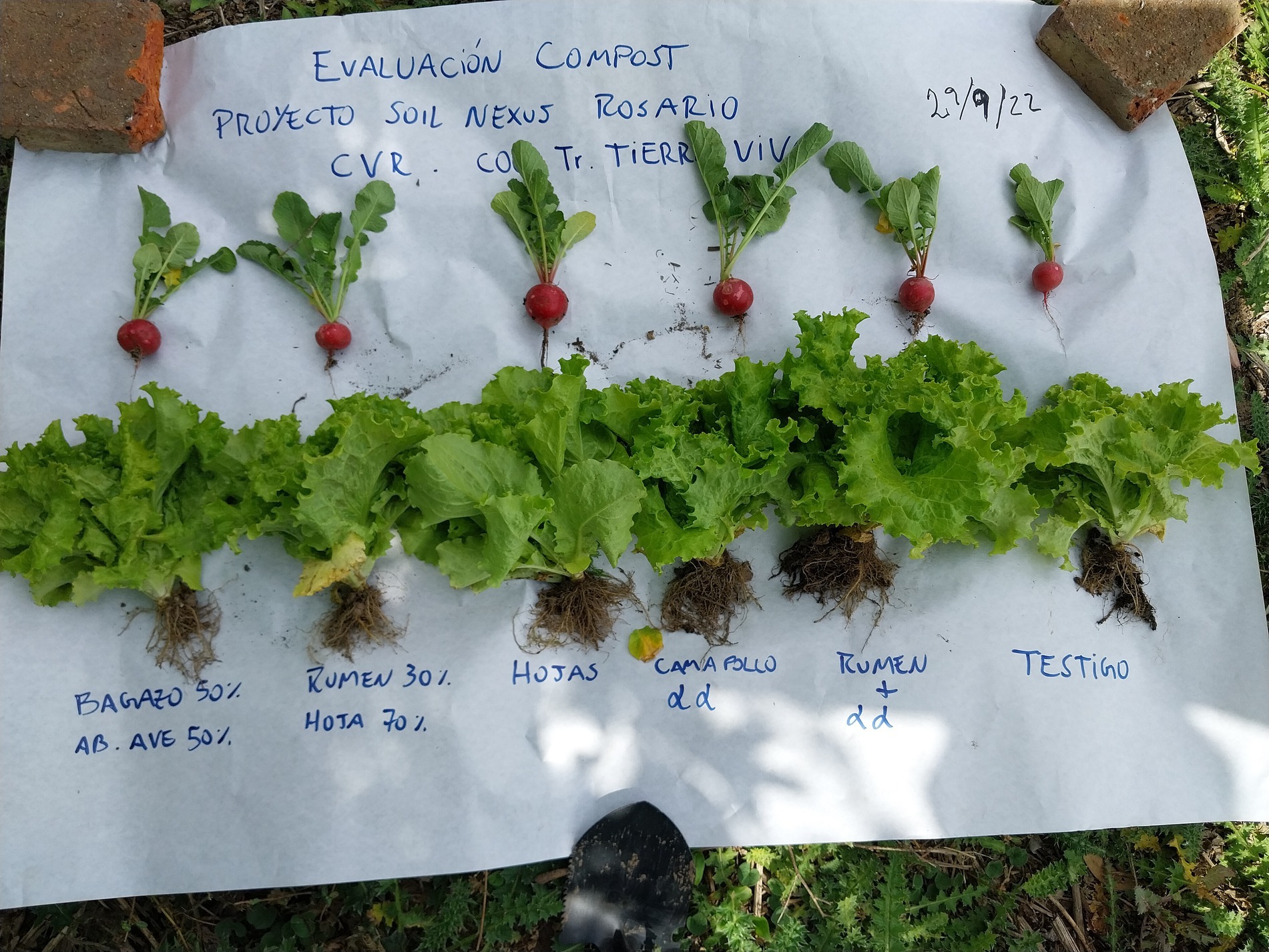
Figure 6. Lettuce and radish produced in the essays of soil remediation at the TTV periurban farm, Rosario, Argentina, in the period of the Southern Hemisphere spring (September–November) 2022. Note: The percentage contribution of each type of compost or compost mixtures is detailed as follows (from left to right): 50% brewer’s bagasse +50% family poultry manure; 70% public tree leaves +30% rumen (cow’s stomach); 100% public tree leaves; 70% chicken litter +30% alfalfa; 70% rumen +30% alfalfa. Also, without amendments was employed (far right).
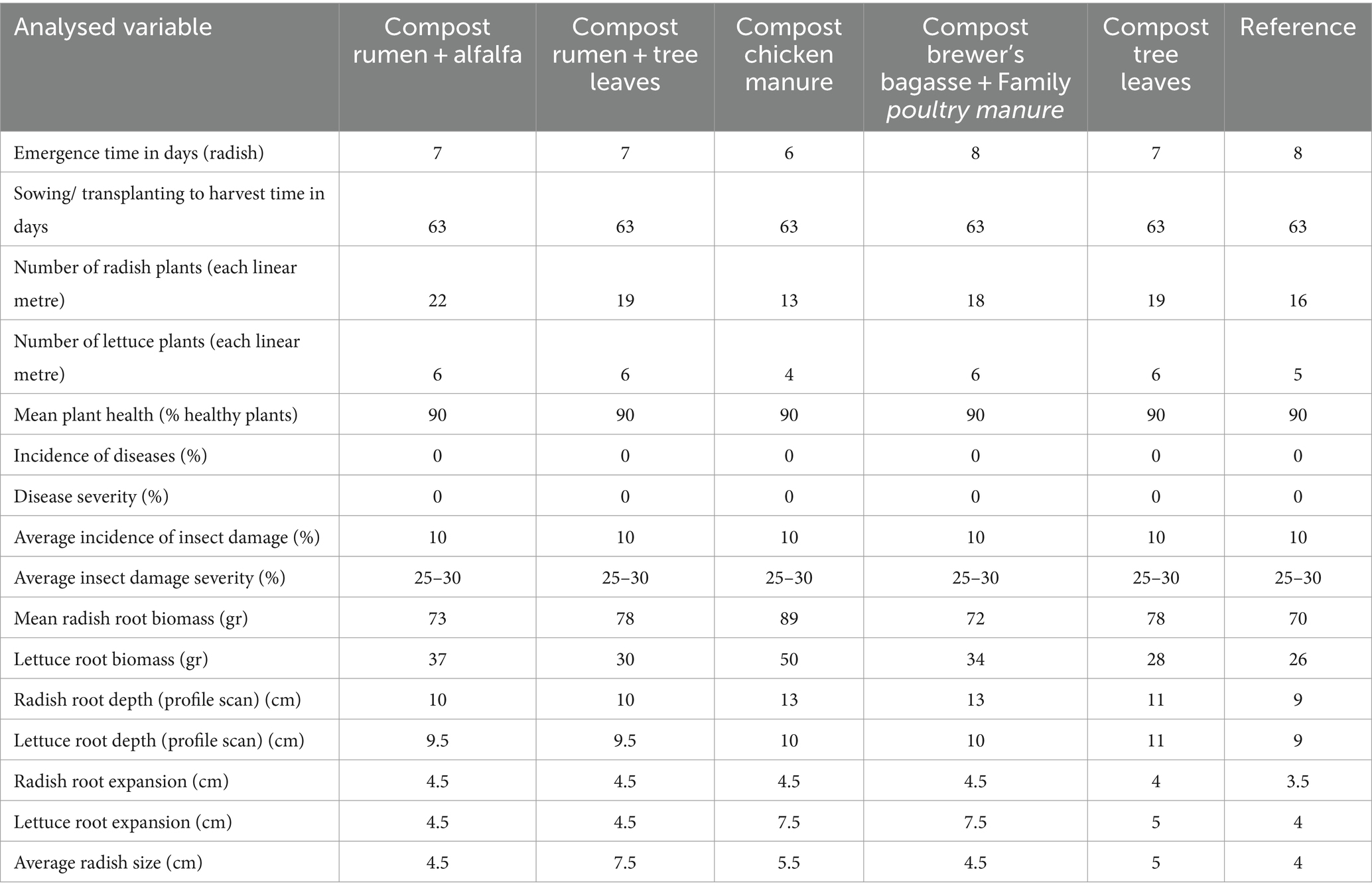
Table 1. Results of the production behaviour of lettuce (Lactuca sativa) and radish (Raphanus sativus) in response to treatment with different composts evaluated in the present Soil Nexus Rosario project.
3 Results
The obtained results for soil treatment, employing different composts incorporated in the urban soils, are detailed in the following items.
3.1 Results of productive behaviour when fertilised with the different evaluated composts
Table 1 shows the results achieved on the productive response to the different types of evaluated composts, carried out at the periurban farm Trabajo en Tierra Viva (TTV), located in the periurban area of Rosario. The good health of the plants should be highlighted, demonstrating that it is possible to achieve healthy plants, without the use of chemical synthesis inputs. In the different measured parameters, there was a positive response with respect to the unfertilised control soil, the last one with none of the evaluated composts. In the fertilised plants, biomass weight and root expansion stood out. In the plants fertilised with chicken manure, the time of emergence was lower and root biomass and expansion were higher for both vegetables in comparison to other fertilisers (Table 1).
It is noteworthy that lettuce grown on chicken litter compost has a lower emergence (4 plants per m2). This response is linked to and confirmed by the phytotoxicity test (see Table 2), which identifies this inhibitory action of the chicken litter in the arugula seed emergence test on the different composts carried out in the laboratory.
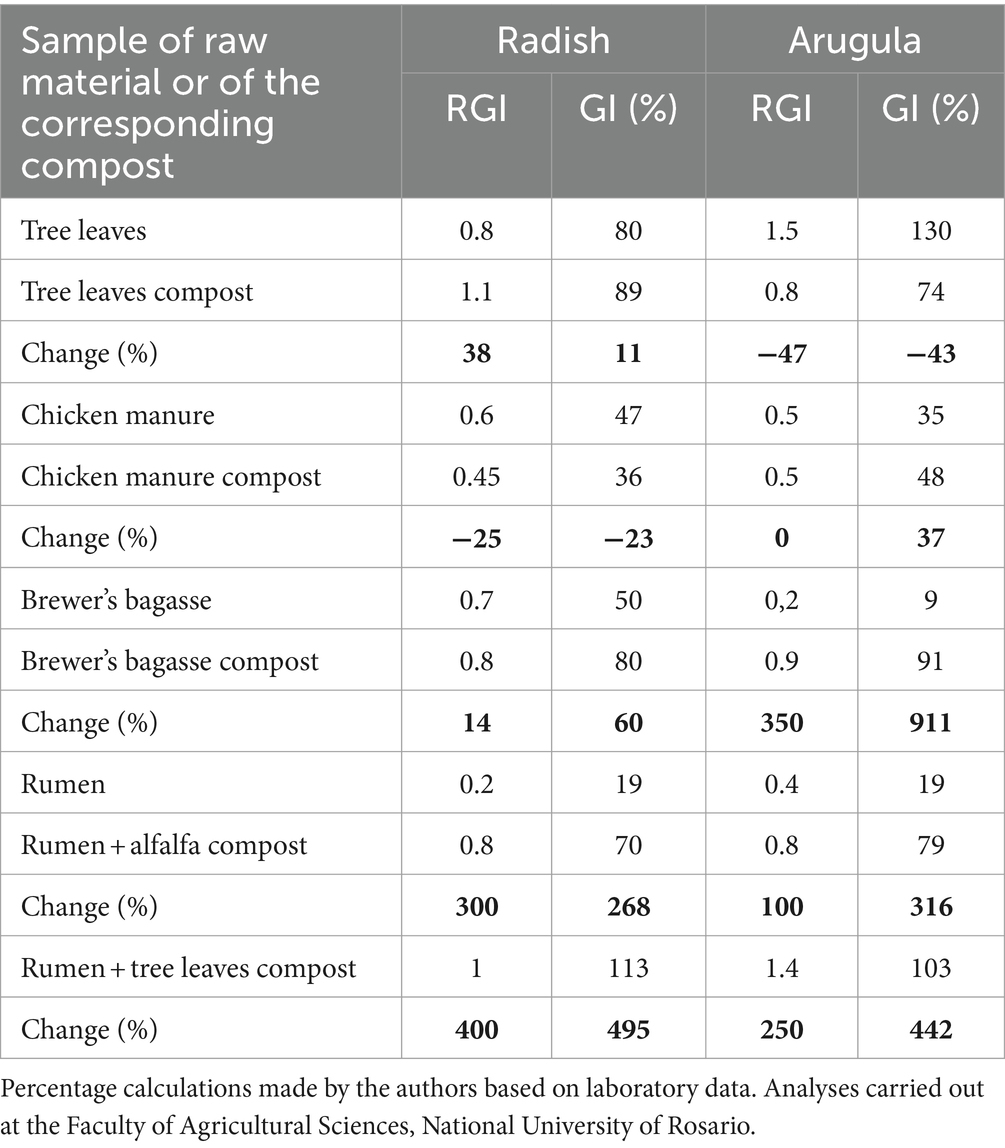
Table 2. Tests of raw materials (substrates) and composts used in the phytotoxicity trials, as described in the text.
Table 3 shows that the soils where the tests were carried out have a good percentage of organic matter (OM; 7% in dry basis for the periurban TTV farm and 9.89% for the horticultural urban park La Tablada), which indicates an OM content even above the considered ideal for soils in the region (5%). pH is moderately alkaline in TTV (8.13) and slightly alkaline in La Tablada (7.18). In addition, there are values indicating good microbial activity above the reference values. Although these good fertility conditions do not allow for any noticeable response to the different fertilisers, higher values were recorded for the different variables analysed for the different composts applied, compared to the control.
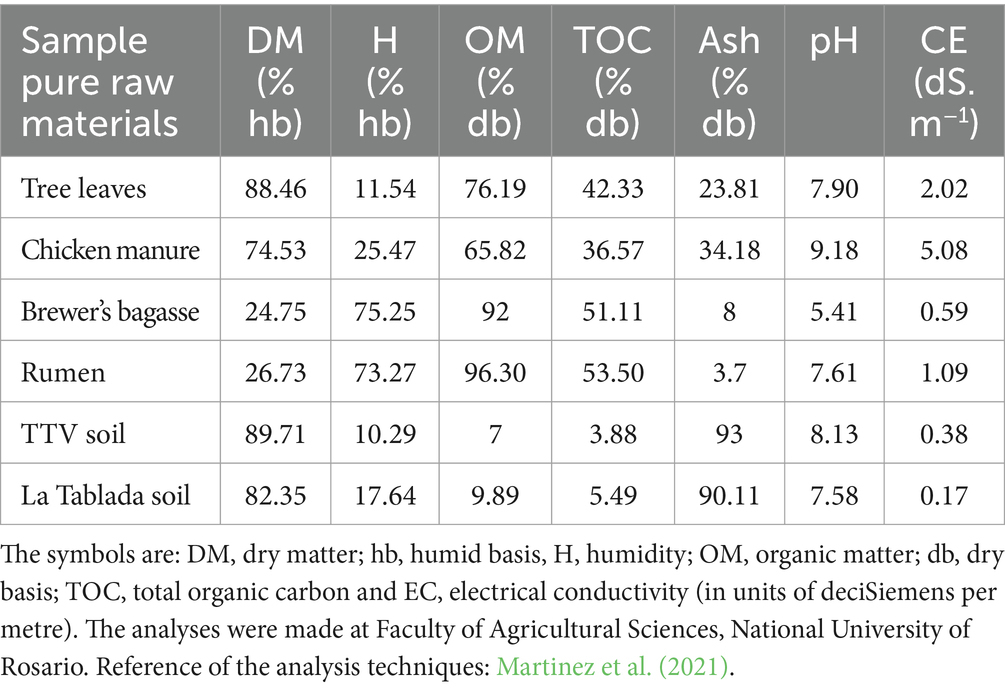
Table 3. Results of the raw materials (substrates) for compost treatments and of the two reference soils at La Tablada urban agroecological park and TTV periurban farm (of the Rosario greenbelt), in Rosario city, Argentina.
3.2 Physicochemical analysis of raw materials for compost production, soils and composts
A detailed analysis was made of the physicochemical properties of the different types of compost employed in the present experiment. The obtained results for the mean data of the horticultural park La Tablada and the periurban farm TTV of each compost treatment are displayed in Table 3. In the case of the raw materials, its humidity (H) varies between 96.3 to 65.82% and the reference soils had rather low humidity, varying between 10.29 and 17.64%. These low values can be explained by a high drought due to a persistent La Niña climatic event that extended for several years in the Pampean region. The organic matter (OM) and total organic carbon (TOC), vary in the range of 65.82 and 96.3% for OM and 36.57 and 53.5% for TOC. Dry ash varies in the range of 3.7 and 34.18% and in the case of the reference soils, between 90.11 and 93%. The pH, in the case of chicken manure presents the highest value (9.18), the rest being in the range 5.41–8.13. The TTV peri-urban farm presents a rather high value of pH (8.13). With respect to electrical conductivity (EC) and pH, chicken manure is the only case in which these properties are significantly different from the others.
Table 3 shows that the OM content was 7% for the periurban TTV farm and 9.89% for the horticultural park La Tablada, which is higher than soils in the regions (with values of 5%).
Comparing the data in Table 3 (about raw material) and Table 4 (about compost), it is interesting to note that the pH values of the composted materials are moderate and give optimum values between 6.5 and 7.5, while the source materials give extreme levels, as in the chicken manure (9.18) and neutral to acidic, as in the case of brewer’s bagasse (5.41). As for electrical conductivity, a parameter associated with soil salinity, the poultry substrate, in turn, shows the highest values, a situation that would reflect a limiting factor, given that the soils of Rosario have high EC. However, the same is the one that provides the highest values of organic matter. Nevertheless, it can be affirmed that all of them show high levels of this compound. In this sense, the physical–chemical results would indicate the convenience of using composted materials.
Based on the data shown in Table 4, the chicken manure compost has a high electrical conductivity in relation to the other composts, partly due to the high content of minerals such as Sodium, Phosphorus and Potassium. In the case of the basic nutrients of interest in agronomy, Nitrogen, Phosphorus and Potassium, the chicken litter compost presented the highest levels, while the other composts maintained similar levels.
3.3 Biological activity analysis of compost, soil and compost feedstocks
Table 5; Figure 7 details the laboratory results of the biological activity analysis of the following parameters: Total carbon content of microbial biomass, total biological activity, total aerobic heterotrophic, cellulolytic, microaerophilic nitrogen fixers, Phosphorus solubilising bacteria and (qualitatively) Phosphorus solubilisation potential. All the different materials (compost, soil and compost feedstock) were subject to the analysis.
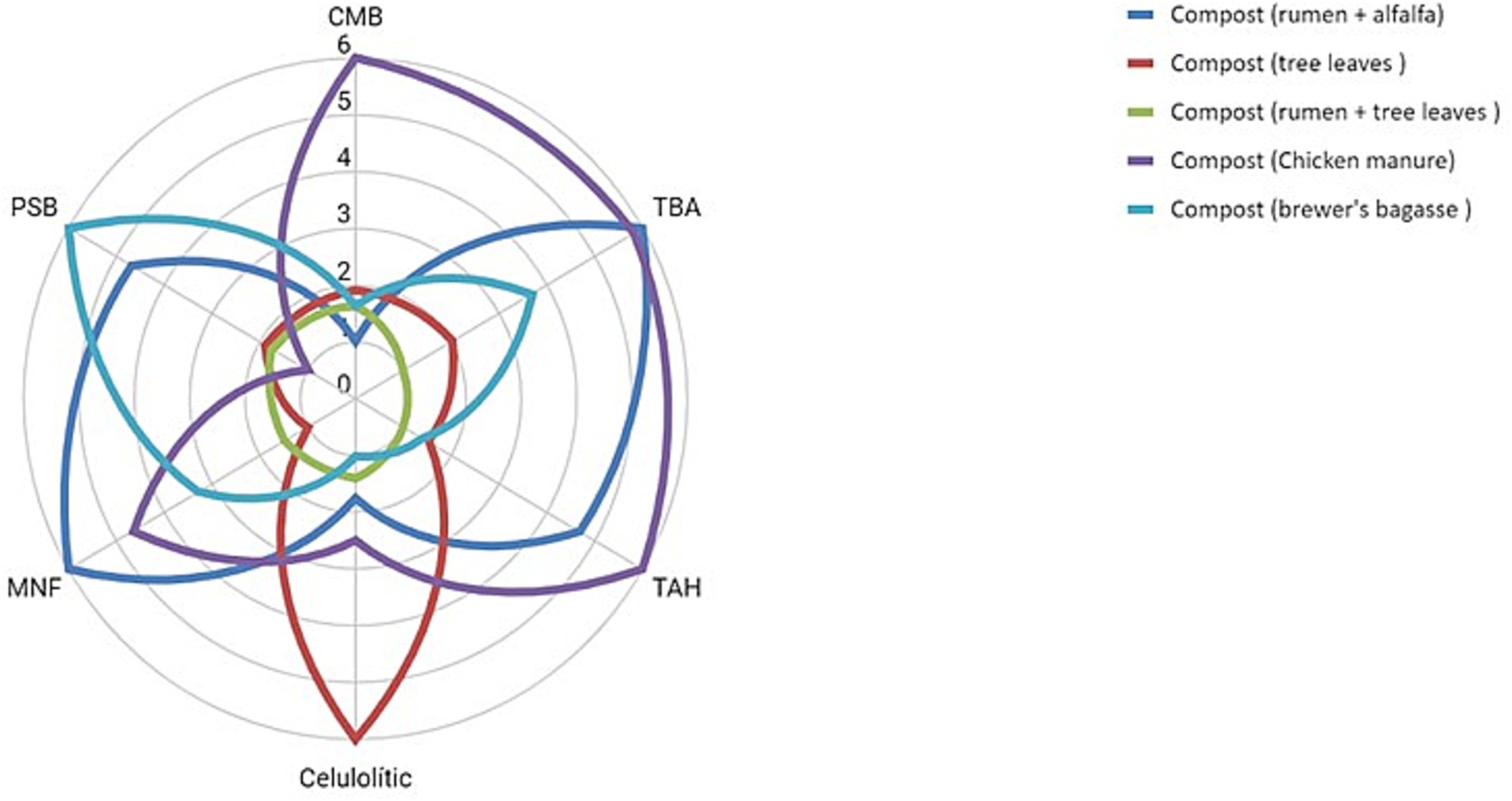
Figure 7. Relative values of microbiological analysis parameters for the studied composts, based on data of Table 5. The ranges in this figure of the measured parameters were considered from 1 to 2.5 as low level, from 2.51 to 4.5 as medium level and from 4.51 to 6 as high level. The symbols correspond to: CMB: total carbon content of microbial biomass; TBA: total biological activity; TAH: total aerobic heterotrophs; MNF: microaerophilic Nitrogen fixers; PSB: Phosphorus solubilising bacteria.
In relation the results presented in Table 5, it must be pointed out that the ecosystems with high functional diversity are more productive, resilient and resistant to certain disturbances (Tilman et al., 1997; Ricotta, 2005) and it can be considered that, if all microorganism functional groups are present in an ecosystem, its functioning is guaranteed, regardless of the specific diversity.
One way of being able to analyse biodiversity is through the isolation and quantification of microbial populations. The study of soil microbiota and organic amendments is done by assessing the biodiversity and/or activity of microorganisms in nature.
The functional structure of the microbial community of different environments, can be approached by studying functional groups. These are groups of microorganisms that perform similar metabolic processes, regardless of their taxonomy. They are formed by several species characterised by the utilisation of available resources in a similar way; therefore, they compete and present similar responses or effects on certain ecosystem processes (Zamora et al., 2012).
Soil microbial biomass, a small and highly dynamic pool of organic matter, plays a critical role in fertility. This soil microbial biomass is detailed in the CMB column of Table 5 in mass units of Carbon per unit of mass and its relative importance for each compost in Figure 7. It is the fraction of organic Carbon found in living microbial cells and constitutes one of the most labile soil C fractions.
Enzymes responsible for the Total biological activity (detailed in the TBA column of Table 5 in units of mass of fluorescein per unit time and mass and its relative importance for each compost in Figure 7) hydrolysis are abundant in the soil environment. Non-specific esterases, proteases and lipases, which have been shown to hydrolyse TBA, are involved in the breakdown of many types of tissues. Therefore, the ability to hydrolyse TBA appears to be widespread, especially among the major decomposers, bacteria and fungi (Schnürer and Rosswall, 1982). Generally, more than 90% of the energy flow in the soil system passes through microbial decomposers, therefore, an assay that measures the decomposer activity of microorganisms provides a good estimate of total microbial activity.
Heterotrophs are a group of microorganisms, including yeasts, fungi and bacteria, that use organic Carbon as a sole source of energy. The number of colonies of these microorganisms per unit of mass, is detailed in the TAH column of Table 5 and its relative importance for each compost in Figure 7. Many heterotrophic organisms consume Carbon compounds, such as sugars, alcohol and organic acids, as food sources. However, there are some specialised organisms that are capable of breaking down cellulose (cellulolytic microorganisms), lignin, chitin, keratin, complex hydrocarbons, phenol and other substances. Heterotrophic organisms are usually found in soil, water, food and soil beds of water bodies. There is no universal test for the measurement of total aerobic heterotrophs. In general, because of the wide variety of test methods and the diversity of organisms, a method must be selected that is suitable for the sample being tested and the emphasis should be on trends rather than absolute values obtained in the various counts.
These microorganisms capable of breaking down cellulose are detailed in the column Cellulolytic (in units of most probable number per unit of mass) of Table 5 and its relative importance for each compost in Figure 7.
One of the most abundant sources of Nitrogen is the atmosphere. It is composed of 78% of molecular forms of dinitrogen (N2), consisting of a very stable covalent triple bond, making it practically inert and inaccessible to most living beings (Mayz-Figueroa, 2004). Diazotrophic microorganisms are those that possess the enzymatic mechanism capable of reducing atmospheric Nitrogen to assimilable ammonium in a process called biological nitrogen fixation, which are related to the data presented in column of microaerophilic Nitrogen fixers (MNF) of Table 5 (in units of most probable number of microaerophilic Nitrogen fixers per unit of mass) and its relative importance for each compost in Figure 7.
Phosphorus solubilising bacteria (PSB) can promote plant growth by solubilising inorganic phosphates (Fernández et al., 2005). The number of colonies of these bacteria per unit of mass are given in the PSB column of Table 5 and its relative importance for each compost in Figure 7.
As for the microbiological contribution, according to the analyses carried out (see Table 5), a significant presence of the total microbial activity can be observed, considering the reference values as recommended values to be reached for CMB: 180 to 500 μg of CMB.g−1. h−1 and for TBA: 70.0 to 300 μg of Fluorescein.g−1.h −1. As a result of the comparison between the different composts detailed in Figure 7, the measured levels of the microbiological activity can be considered low, medium or high (with values as given in the legend of this figure), with respect to the other analysed substrates.
From Table 5; Figure 7 it can be derived the following conclusions about the different composts:
– Tree leaves compost: Relative values were obtained that provides a relatively high amount of cellulolytic microorganisms, low amount of plant growth promoters solubilising inorganic phosphates (BSP), low decomposer activity (TBA), low organic matter occupied by microbial biomass (CMB), low population of yeasts, fungi and bacteria using organic Carbon as the only source of energy (TAH) and low amount of N-fixers (MNF).
– Tree leaves + rumen compost: Relative values were obtained describing that it provides medium amount of cellulolytic and N-fixing microorganisms (MNF), low amount of plant growth promoting solubilizers of inorganic phosphates (BSP), low organic matter occupied by microbial biomass (BMC), low decomposition activity (TBA), low population of yeasts, fungi and bacteria using organic carbon as sole source of energy and carbon (TAH),
– (Malt) brewer’s bagasse compost: Relative values were obtained describing that it provides a high amount of plant growth promoters solubilising inorganic phosphates (BSP), medium amount of N-fixers (MNF) and medium decomposition activity (TBA), low amount of yeasts, fungi and bacteria using organic Carbon as sole source of energy and Carbon (TAH), low amount of organic matter occupied by microbial biomass (BMC) and low amount of cellulolytic microorganisms.
– Rumen + alfalfa compost: Relative values were obtained describing that it provides a high amount of N fixers (MNF) and decomposer activity (TBA), medium amount of inorganic Phosphate solubilising plant growth promoters (BSP), medium number of yeasts, fungi and bacteria using organic Carbon as sole source of energy and Carbon (TAH), low amount of organic matter occupied by microbial biomass (CMB) and low amount of cellulolytic microorganisms.
– Chicken manure compost: Relative values were obtained describing that it provides a high population of yeasts, fungi and bacteria using organic Carbon as the sole source of energy and Carbon (TAH), high decomposer activity (TBA), high organic matter occupied by microbial biomass (CMB), medium amount of N-fixers (MNF), medium amount of cellulolytic microorganisms and low amount of plant growth promoting solubilizers of inorganic Phosphates (BSP).
It can be concluded that the tested soils have acceptable to good microbial activity of functional groups, particularly that of the agroecological park La Tablada, and that the various composts contribute to raising the population of helpful microbes and triggering various nutrient cycles. According to the principal functional group discovered in each soil, one or the other may be suggested, based on the nutritional shortage of each soil, as explained in the description of each combination of substrates.
From a biological perspective, it can be claimed that, except for bacteria that solubilise Phosphorus, the compost made from chicken manure would include the greatest variety and abundance of microorganisms. High diversity and abundance of microorganisms would be present in rumen + alfalfa compost, but there would be little organic matter occupied by microbial biomass and few cellulolytic bacteria. Most of the microorganisms in the rumen + leaves compost are cellulolytic and microaerophilic Nitrogen-fixing organisms, which have low diversity and low abundance. Microorganism variety and abundance in the composted leaves are modest, with a predominance of cellulolytic microbes. Low diversity and number of microorganisms would be present in (malt) brewer’s bagasse compost, but it could enhance biological Nitrogen fixation and phosphate solubilisation.
3.4 Biophytotoxicity analysis of raw materials and composts
The use of the phytotoxicity bioassay allows a comprehensive assessment of effluent toxicity, generated by mixing the substrate or compost in water, simulating an extraction of soluble components from these matrices and studying the germination of seeds and root development in this liquid effluent. Seedling mortality or stunting can be affected by the presence of various toxic compounds. The content of ammonium, soluble salts and organic acids, in high concentrations, inhibits root development and nutrient uptake. Seeds of a selected specie are exposed to a range of effluent concentrations to evaluate the toxicity of germination and root elongation during the first days of development. Using phytotoxicity indices, this method enables determining the sample’s level of toxicity. This methodology is applicable to evaluate the phytotoxic effects of raw effluents or products obtained after a treatment process (digested products from anaerobic digestion, among others; Martinez et al., 2021).
The relative growth index (RGI), which compares the growth of roots of a species in a substrate under study—in this case, the composts and raw materials with the growth of roots in water as a control, is one metric used to describe this process. Its calculation is achieved by means of the following formula:
where J is the average root length in the effluent concentration (in mm) and G, is the average root length in the negative control (mm). The RGI reference values are: (a) Inhibition of the radicular elongation when 0 ≤ RGI < 0.8, (b) No significant effects exist when 0.8 ≤ RGI ≤ 1.2 and (c) S𝑡𝑖𝑚𝑢𝑙𝑎tion of the radicular elongation when RGI > 1.2 (Martinez et al., 2021).
In the laboratory, radish and arugula (Eruca sativa) were used to evaluate how their roots develop in these materials. The tests were carried out putting the seeds in an aqueous solution, based on the different analysed substrates. For the compost raw materials (tree leaves, chicken manure, brewer’s bagasse and rumen), values below 0.8 were recorded in the case of radish, inferring that root elongation inhibitors exist in these materials. In the case of the arugula trial, the effect was similar except for tree leaves, which had an RGI value of 1.5, inferring then that there is stimulation of root elongation (see Table 2).
Another important test parameter is the Germination Index (GI), which relates the number of seeds that germinate in a substrate,—in this case in raw materials and composts, referenced to the number of seeds that germinate in a control substrate such as pure water. It is calculated as follows:
where RGI is determined from formula (1), I is the number of seeds germinated in each effluent concentration and E the number of seeds germinated in the negative control in water. The reference value is: Inhibition when 𝐺I < 80%.
For the behaviour of the composts, similar values are obtained for both test materials (radish and arugula), except for the RGI of the rumen + leaf compost tested with arugula which is 1.4, i.e., with stimulation of root elongation, while for radish there is no significant effect. Likewise, in the case of chicken litter, it is noteworthy that for both materials there was inhibition of root elongation.
3.5 Microbiological analysis of pathogens
Table 6 displays the results of the number of faecal coliforms in the different composts (leaves, chicken manure, brewer’s bagasse and rumen).
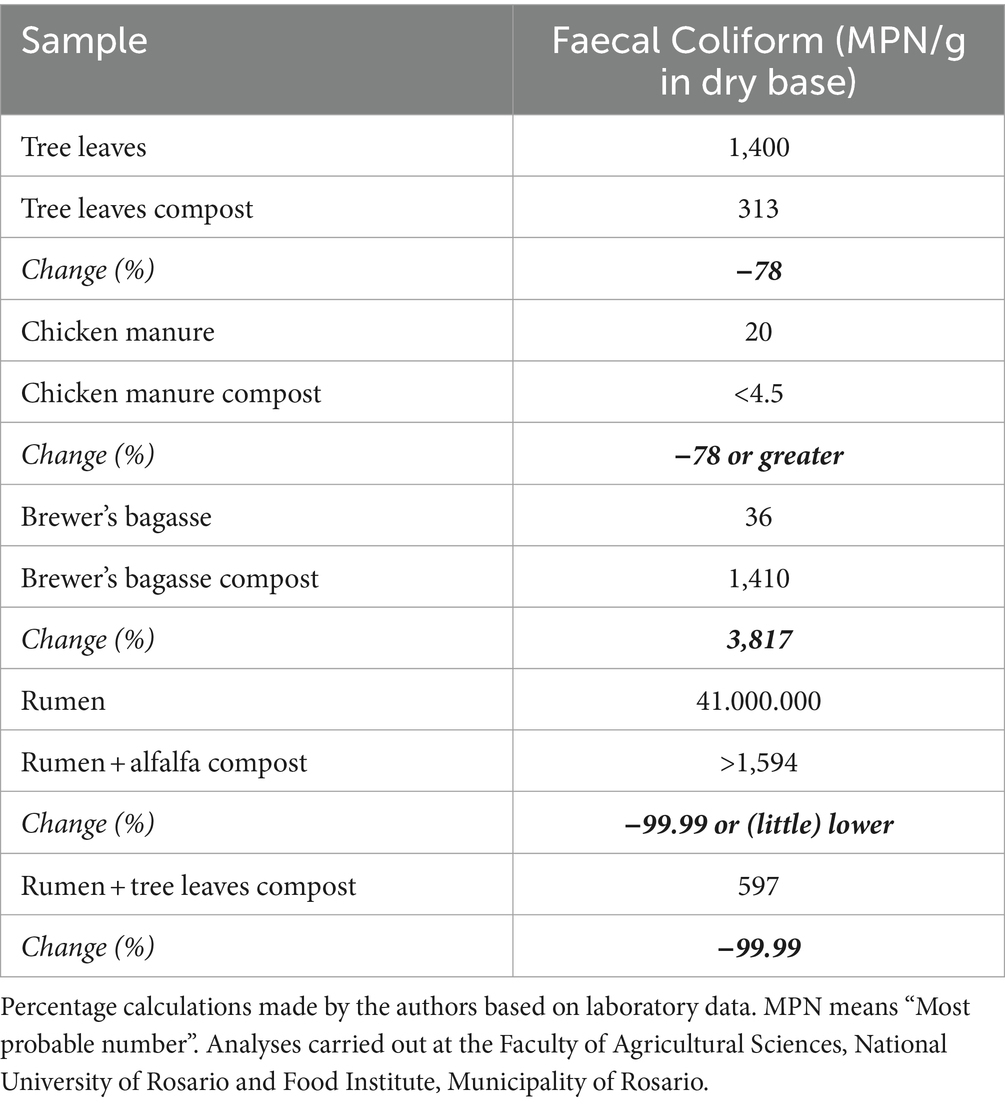
Table 6. Faecal coliform bacteria counts and their variation from the main raw material (substrate) to the finished product.
The Argentinean standard established by SENASA (Argentina National Service of Health and Agrifood Quality) standard 1–2019 indicates that the limit value for faecal coliforms should be below 1,000 MPN.g-1, where MPN stands for Most Probable Number. Consequently, concerning the substrates, chicken litter and brewer’s bagasse are below this limit. In the case of compost, those made with urban tree leaves, chicken manure and the combination of rumen and tree leaves satisfy the SENASA norm.
A microscopic analysis of both vegetables (radish and lettuce), compost and reference soil show the absence of structures compatible with parasites.
The microbiological determinations carried out on the finished compost are also detailed in Table 6. To analyse the content of Salmonella spp., TMECC 07.02-A1-2 technique (established by SENASA as an official reference analytical technique) was used and in all compost samples the result was less than 1/4 MPN/g on a dry basis. Thus, it is possible to verify the reductions in the content of coliform bacteria, where it can be observed that all the processes were successful in reducing the content of faecal coliform bacteria, except in the case of the brewer’s bagasse compost, where it is presumed that it may have been contaminated during storage in the field.
3.6 Toxicity analysis
The substances investigated in this section are metals, antibiotics and agrochemicals. They are classified as contaminants for human foodstuffs, as ingestion of these at certain levels could cause health problems.
3.6.1 Heavy metals
For the heavy metals investigated, Cadmium (Cd), Mercury (Hg), Lead (Pb) and Arsenic (As), levels in the order of micrograms per Kg, i.e., thousandths of ppm (parts per million), are observed (see Table 7).
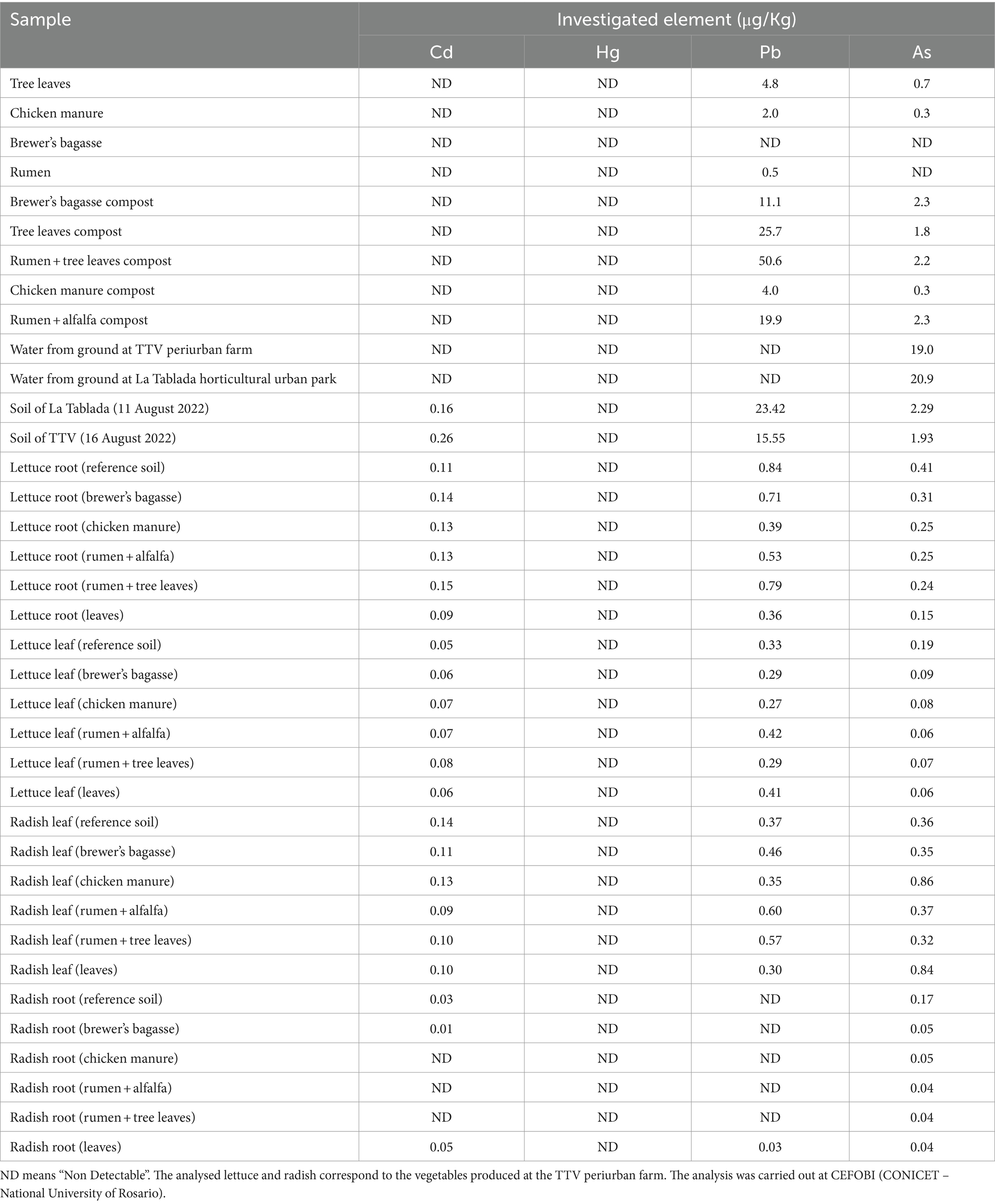
Table 7. Heavy metals present in the raw materials (substrates), compost, reference soils, water and vegetables (lettuce and radish).
According to SENASA Resolution 1/2019 (SENASA, 2019), for a compost to be classified as Class A (which are those that can be applied without any type of restriction), the levels of the following elements expressed in μg/Kg of dry matter must be below the detailed values: Cadmium (Cd), 1,500 μg/Kg; Mercury (Hg), 700 μg/Kg; Lead (Pb), 100,000 μg/Kg and Arsenic (As) 15,000 μg/Kg.
In the case of Arsenic, in the raw materials, this metal is only detected in the raw material (tree leaves and chicken manure), while in the resulting tree leaves compost, the level rises up to 2.5 times. For both analysed waters for irrigation from ground, it is detected a level higher than the recommended level for human consumption (10 μg/Kg), making it unsuitable for direct consumption. The Santa Fe province where Rosario city is placed, have many regions with Arsenic in water with values higher than the accepted ones (Report published on line by the Academy of Medical Sciences of the Santa Fe province, Lombardo et al., 2020).
For Lead, its content in leaves is the highest in relation to the other raw materials, and the resulting composts (rumen + tree leaves and leaves) have the highest levels of Lead content. This could be due to a decrease in the Carbon, moisture and Nitrogen contents per Kg of leaves, as a result of the microbial metabolism in the composting process, which is concentrated at the end of this composting process. Also, high levels of this element can be observed in the roots of the cultivated vegetables, with the exception of radishes.
3.6.2 Antibiotic content
Samples of compost (of the different substrates under study), soil and water from the two production areas where the trials were carried out and vegetables produced, −lettuce (Lactuca sativa) and radish (Raphanus sativa) at the TTV periurban farm, were sent to the laboratory of the Environmental Research Centre of the National University of La Plata and CONICET. A detailed study was done that permitted to determine the content of antibiotics, ionophores and pesticides.
In the case of the antibiotic ionophores identified, Table 8 displays the results obtained of the Concentration of toxic chemical substances measured in raw materials, compost and reference soils. The symbol LDM means, the Limit of Detection Method. The highest registered values correspond to Monensin, in the cases of Chicken manure (raw material and compost) and Rumen, exceeding in orders of magnitude to the rest of the analysed substances. For the two analysed samples of soil of the horticultural park La Tablada and the peri-urban farm TTV, in the first case, even if they differ by a factor of about two, this is not very significant and in the second case, both results are very similar.
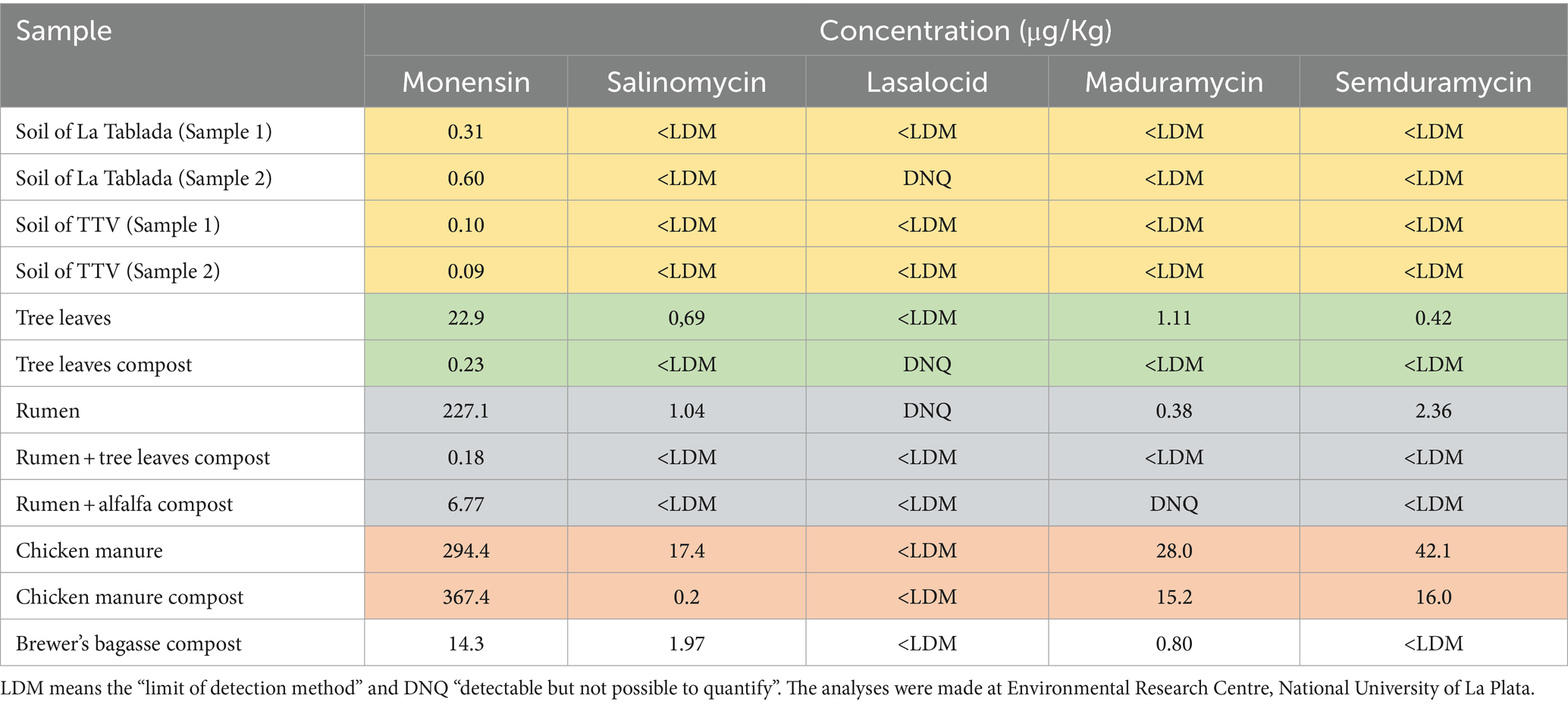
Table 8. Concentration of toxic chemical substances measured in raw materials, compost and reference soils.
In the case of the residues investigated and according to the data detailed in Table 8, relevant levels of Monensin have been detected, which is an antibiotic with the potential to improve feed conversion efficiency through chemical manipulation of the end products of rumen digestion by the lethal effect on certain bacteria in the rumen environment and selection of those resistant microorganisms that make the digestion of feed consumed by ruminants more efficient. It is a widespread practice in feedlot fattening systems (Bretschneider, 2009; Vyas et al., 2018). In poultry production, it is used as a coccidiostat (a substance that retard the growth and reproduction of coccidian parasites) in the poultry health plan (Odriozola, 2004).
High levels of Monensin were detected in chicken manure (294.4 μg/Kg) and in the corresponding compost (367.4 μg/Kg) where it is concentrated.
3.6.3 Agrochemical content
Regarding the content of agrochemicals in the different substrates analysed, 77 pesticides belonging to 5 major groups (herbicides, fungicides, insecticides, metabolites of active ingredients and synergists) were traced. The results of the analyses referred to two values, to indicate the active ingredients present: detectable and quantifiable.
In water, different sources were searched, the drinking water network of the city of Rosario (AG1), irrigation water from the two trial sites,—horticultural park La Tablada (AG5) and the periurban farm TTV (AG2). In the analyses carried out, 2,4,D and atrazine herbicides were detected at values below the limit of quantification in AG1 and AG5.
Also, detections of Atrazine hydroxy were made in AG1 and AG2; Metolachlor in AG1, AG2 and AG5; Fungicides: Azoxycystrobin in AG1 and AG3; Difenoconazole, Epoxiconazole and Tebunoconazole in AG1 and AG2 and Imidacloprid insecticides in Rosario water supply and in groundwater, in both test sites.
In soil, traces of herbicides 2,4,D, Atrazine and Metolachlor were detected in AG3 and AG5 sites and Glyphosate only in AG2. Fungicides were not detected and the insecticides Imidacloprid and Piperonyl butoxide as synergist, but always at DNQ (detectable but not possible to quantify) levels.
In the raw materials and composts is where the highest presence of active ingredients at DNQ or low levels are detected in 23 of the 77 pesticides traced. Difenoconazole is the pesticide with high level of presence in all analysed substrates, with the exception of leaves as raw material. Thus, in the raw materials, they were identified in tree leaves (0.51 μg/Kg), rumen (14.30 μg/Kg), chicken manure (40.96 μg/Kg) and for their respective composts, they were recorded in tree leaves compost (163.21 μg/Kg), rumen + tree leaves compost (191.61 μg/Kg), brewer’s bagasse compost (177.64 μg/Kg), rumen + alfalfa compost (154.91 μg/Kg) and in chicken manure compost (105.68 μg/Kg). As can be seen, a significant increase of the respective values is observed in their composted materials.
In the tested vegetables, low values and DNQ were detected in lettuce (L. sativa) for three active pesticides (2,4,D, Imidacloprid and Tebuconazol) and in radish (R sativa) for four pesticides (2,4,D, Azoxystrobin, Imidacloprid and Tebuconazol). The sources of these contaminants are estimated to be due to the use of conventionally treated seedlings (lettuce) and seeds (radish), which is the most common practice among growers.
4 Limitations of the present and similar studies
The first limitation of this study is of a conceptual or even ontological, nature. By definition, agroecology is a type of agriculture that –alongside taking care of people- takes care of the Environment (the air, water, soil and all living organisms above and below ground), with special emphasis on the reduction (and possible elimination) of contaminants that could affect the food chain and the whole soil web. Working with urban organic waste materials from a range of food industries and green spaces which have been exposed to agrochemicals, pesticides, pharmaceuticals or car-born pollution, might seem a contradiction. However, in a world where pristine nature no longer exists, where many communities have to “live with the trouble” of urbanisation and pollution for their survival (Tsing, 2015; Haraway, 2016) the question of how to build agroecological farms in the debris of urbanisation, taking stock of what we have done and navigating the landscape armed with hopes for a better world, remain relevant. This work, however, pushes the boundaries of agroecology and embraces the controversial challenge to think what an urban agroecology might mean, what risks it brings about and what considerations should be included in a regulatory framework.
A second limitation to this study that we have identified is related to the mechanics of composting: usually the raw materials used to produce compost are not uniform (chicken manure that are provided from different sources, leaves that are collected from different trees, etc). Different batches of compost could have different loads of pollutants. This study is a pilot realised with a small budget in a relatively short period of time. We think it is important to repeat this study longitudinally to obtain more nuanced results, specifically in relation to different combinations of compost and different crops cultivated in them. Given the limited timeframe for our research we only tested two quick growing crops (lettuce and radish). Further studies should consider vegetables with longer growing cycles, as well as fruit crops.
The geographical location of the soil used for vegetable production also influence the obtained results, due to soil composition, climate (including ambient and soil temperature and humidity, wind speed, precipitation, etc), availability of farmers and technicians with enough knowledge of agroecology and related subjects, among others. These factors impact also on the bioavailability of pollutants for different crops. Consequently, the results obtained in an experiment (like the present one) can be considered as a valid reference for the conditions in which the experiment has been developed. For broader generalisation, comparable and systematic research across geographies is needed.
5 Discussion
On the basis of all the analyses and data evaluation carried out in the laboratory and in the field, the following conclusions can be derived:
– All the materials and composts analysed have interesting attributes for their potential use as manure and fertilisers for the production of organic foodstuffs. They all have a high content of organic matter and biological activity. In the field test, all the materials showed positive responses with respect to the unfertilised control, even considering that the control soil had high fertility values, so it can be deduced that in degraded soils, the response can be estimated to have a greater impact. Each has its own particular characteristics that make it recommended or indicated to remedy deficiency situations or to facilitate specific processes. The focus is rather on the limitations that each material presents in terms of the sources that gave rise to it and that may restrict its use as a fertiliser, mainly for use as an input for agroecological food production.
– We begin with chicken manure which, according to the horticultural census carried out by INTA (Instituto Nacional de Tecnología Agropecuaria) in the metropolitan region of Rosario (Mondino, 2022), is used as fertiliser by 84.14% of horticultural producers (54% without composting). It provides a high amount of organic matter, total Nitrogen (N), Potassium (K) and Phosphorus (P). Consequently, it is a positive substrate to be used as a soil amendment to restore part of the chemical fertility. It also provides a large population of yeasts, fungi and bacteria that use organic Carbon as the only source of energy and Carbon (TAH), high decomposing activity (TBA), high organic matter occupied by microbial biomass (CBM) and medium amount of N fixers (MNF). As limitations, this substrate presents the greatest difficulty, due to its high pH index as raw material (9.8), which decreases to 7.59 when composted. Likewise, high electrical conductivity (EC) values are identified, ranging from 5.8 dS.m−1 to 18.4 dS.m−1 respectively, with SENASA indicating values lower than 4 dS.m−1 as a reference, to consider a compost without restriction of uses Wilson (2017) warns about values greater than 6 dS.m−1 for agricultural use. When correlating these data with biophytotoxicity (Table 2), chicken manure continues to present limitations in both, the germination index (GI) and the root elongation (RGI), which in turn have been manifested in the vegetable trial, with the plots fertilised with this substrate obtaining the lowest plant/(linear metre) indexes in both lettuce (L. sativa) and radish (R. sativus). The high Sodium (Na) content in this compost would be the most negative parameter, as it would have the potential to affect the soil structure, causing dispersion of colloids and generating damage to physical fertility, affecting the pore space, the infiltration capacity of the profile and anaerobic conditions detrimental to aerobic microorganisms. It is estimated that these limitations are associated with the production method of the source, linked to confined poultry production (feedlot).
– The analysis of compost and pure raw material also shows a high presence of agrochemicals and ionospheres (monosin), which are not transferred into the respective products. Therefore, a study using poultry manure based on agroecological production or with low use of antibiotics and chemicals would be desirable.
– The compost of leaves from urban trees has shown the highest number of cellulolytic microorganisms, a moderate amount of P solubilizers and a good performance in general in the measured parameters in the production trial of both analysed vegetables. It can be a good substrate for use in soils with a high content of cellulose residues, such as stubble from cereal harvesting, for example. As an observation, the Pb content was 25.7 μg/Kg in the compost and 0.41 μg/Kg in the lettuce leaves. These values are very small compared to the lead (Pb) content limit for the raw material established by SENASA resolution 1/19, which is 100,000 μg/kg.
– As for the brewer’s bagasse compost, the analyses show that its main contribution is inorganic phosphate solubilising plant growth promoters (PSB). It should be noted that the brewer’s bagasse as a raw material has high values of biophytotoxicity and inhibition of root growth, but when composted, this situation is overcome, which is why its use as compost is recommended.
– The rumen as raw material has the highest organic matter (96%) and N values, with a pH of 7.61. It is a fresh material with a high water content, so in this state it has an inhibitory effect on root growth and a low germination index, values that are significantly improved in its composting combined versions: rumen + alfalfa and rumen + leaves from urban trees.
– In the rumen (from fee lots cows) + alfalfa compost, it was detected high content of microaerophilic Nitrogen fixers (MNF) and high decomposing activity of bacteria and fungi (TBA). They act as promoters of microbial activity, as in the case of rumen + leaf compost, that shows a good behaviour in field trials, providing high values of Phosphorus solubilizers. Likewise, a high presence of agrochemicals and the ionophore monesin is observed in the compost version. This is not the case for the final products (lettuce and radish) whose results are below the detectable limits (<LD). For the content of pollutants, the presence of a series of pesticides (herbicides, insecticides, fungicides), −a product of the effluent contamination caused by the agro-industrial production model, can be observed in water from the Rosario network and sub-surface groundwater at values below the limit of quantification. Likewise, for the same reason, ionospheric antibiotics were detected in the raw material (rumen and chicken litter) and compost (chicken litter) of materials from confined animal husbandry.
Preliminary conclusions from the results obtained indicate that:
a. The suitability of soils for food production and the quality of the food obtained is directly related to the biological quality of the soils, the content of contaminants and their capacity to filter them.
b. Cities generate a large amount of organic biological waste that can be reused and used productively for food production.
c. These wastes make a very significant contribution to the biological quality of damaged soils.
d. Each analysed material according to its source and the functional groups of microorganisms they contribute (whether cellulolytic, P solubilizers, nitrate solubilizers, etc) can be indicated as a corrector of the limiting factors of these components in productive soils.
One of the key contributions of the present work is the demonstration that compost is an adequate source of fertiliser to achieve healthy soils and contribute to their biological and nutritional quality. However, one of the main limitations of their use lies in the pollutant load of the generated waste, which is linked to production models with a high load of pesticides and antibiotics from conventional agriculture.
Another key contribution is that the present study tested the remediation capacity of compost and the filtering function of soil, compost and roots to minimise or avoid the presence of these contaminants in the vegetables produced on the substrates used as inputs. In some cases, pollutants were present even after composting. Analysis carried out on the vegetables generally indicate undetectable levels or levels below the admissible limits, demonstrating the filtering capacity of the different composts and the soil. However, given that filtering capacity of soils is not unlimited and, for reasons of safeguarding health and providing conditions for the safe production of healthy food, we recommend the following measures to regulate the use of organic wastes for composting and to strengthen the development of agroecological transition and waste management policies:
i. To promote the reduction of pollutants in agro-industrial production chains, so that their byproducts and organic waste could be safely reused in agroecological production, minimising risks of bioaccumulation of pollutants in soils and crops.
ii. To facilitate the sourcing of organic inputs from agroecological farms/businesses as much as possible.
iii. To deepen studies on the remediation of damaged soils via urban organic waste fluxes, across a diversity of soils and involving a diversity of crops.
iv. To promote the development of regional, metropolitan and municipal policies that encourage the availability of and access to biological substrates that have a high quality and are contaminant-free.
A further element to take into account is the contamination of groundwater used for irrigation. The main problem of excess content of Arsenic can be solved (or at least minimise), by employing Methods for decontamination suggested in the Consensus (on As) promoted by the Academy of Medical Sciences of the Province of Santa Fe, Argentina (Lombardo et al., 2020).
Possible contributions to the mitigation of Climate change (IPCC, 2018, 2021) by Urban and Peri-urban agroecology need also to be considered. In particular, the work of Piacentini et al. (2014) compared short distance transportation of different foods produced in Rosario city and peri-urban region, with respect to a long distance food transportation, obtaining in all cases a reduction greater than 90% of CO2 emissions.
The present study reflects the behaviour of variables that measure the quality of compost, elaborated in the different variants mentioned above, at a given moment in real production conditions, under agro-climatic conditions that occurred in the spring of 2021 in the city of Rosario, Argentina. It would therefore be interesting to carry out further studies in other experimental conditions, to corroborate or improve the obtained results. Also, it invites to reflect on the amount of organic waste generated by the city, which can be assigned a productive use as inputs to produce agroecological food. However, it is important to verify if these wastes have the capacity to be transformed into quality fertilisers, without pollutant residues and with attributes to regenerate the biological activity of degraded soils in their fertility, which is due to urbanisation activities and the extraction of nutrients by the practice of a continuous agriculture, based on a high use of chemical inputs.
A suggestion is made to validate qualitative and quantitative methodologies that can be directly performed in field conditions and at low cost, compared to traditional measurements with laboratory equipment, such as chromatographic analysis on paper that can be used in soil, amendments, compost, biofertilizers, etc. However, it requires training for the interpretation of the results. Another suggested method is the observation with optical refractometer on fruits, leaves, and roots, to infer the nutritional status of crops.
In relation to the comparison of the present work with other works in different parts of the world, is quite difficult, since the conditions related to climate, soil, vegetables, tested composts, among others, are particular of a given location. A specific comparison can be made with the work of Chan et al. (2007), since the geographical place where the experiment was done was New South Wales in Australia, which is in a similar situation as Rosario city (in the latitudinal band 31–33°S). In particular, the C/N ratio of the compost they used had a value of 72, since the mulch products (composted garden organics) had low nutrient concentrations and high carbon content. This value can be compared with the present case, were the different composts had a C/N ratio in the 20–30 range.
Another comparison can be made with the work of Kebede et al. (2023) that analysed the effect on soil properties and the growth and yield of the vegetable Swiss chard (Beta vulgaris L.) in Dilla, Ethiopia, placed in a tropical climate (quite different from the present one). However, similar positive results were obtained, considering different proportions of food waste compost and of leaf and yard compost. The authors detailed that the obtained results indicated that increasing rates of food waste compost significantly (p < 0.001) increased the plant height, leaf area, and fresh yield of Swiss chard.
The present study opens new ways for detailed investigation of the raw materials, the composts and the treated (and non-treated) soils.
Data availability statement
The original contributions presented in the study are included in the article/supplementary material, further inquiries can be directed to the corresponding author.
Ethics statement
Written informed consent was obtained from the individual(s) for the publication of any potentially identifiable images or data included in this article.
Author contributions
RT: Conceptualization, Supervision, Writing – original draft. NM: Investigation, Supervision, Writing – original draft. NP: Conceptualization, Investigation, Supervision, Writing – original draft. FB: Investigation, Writing – original draft. MC: Investigation, Writing – original draft. NB: Investigation, Writing – original draft. CR: Investigation, Writing – original draft. MR: Investigation, Writing – original draft. MI: Investigation, Writing – original draft. TS: Supervision, Validation, Writing – original draft. RP: Investigation, Project administration, Supervision, Validation, Writing – review & editing. KW: Conceptualization, Supervision, Writing – original draft. CT: Conceptualization, Funding acquisition, Project administration, Supervision, Writing – review & editing.
Funding
The author(s) declare financial support was received for the research, authorship, and/or publication of this article. The research for this article was funded by Future Earth and the Gordon and Betty Moore Foundation, for the “Pegasus 3” call project “Soil Nexus” (2020–2022) (grant number G-85451-08). The consortium includes partners from Coventry University, United Kingdom (PI), Ghent University, Belgium; University of Cape Town, South Africa; National University of Rosario, CONICET and ROSCYTEC Foundation, Argentina; Twin Cities Agricultural Land Trust, United States and Compost Mentis, UK for the International Land Care Network; Shared Assets and Quantum Waste, United Kingdom; Spanish Network of Agroecological Cities, Spain.
Acknowledgments
The authors wish to acknowledge the following laboratories: Faculty of Agricultural Sciences, National University of Rosario, the Centre for Environmental Research of the National University of La Plata and CONICET and the Food Institute of the Municipality of Rosario, which carried out the physical-biochemical and toxicological analysis; the Green Belt Programme (Programa Cinturón Verde), which carried out the field trials of compost and crops; the Rosario Agroecological Centre, which produced the analysed compost; the Urban Agriculture Programme, which provided a productive testing area and its maintenance; Prof Dr. Michiel Dehaene (University of Ghent, Belgium) for valuable comments and suggestions; the urban and periurban farmers (Coccito and Chirileison); the members of the TTV Cooperative and La Tablada urban agroecological park and the authorities of the Municipality of Rosario, Argentina. The authors would also like to thank the reviewers for their valuable comments and suggestions.
Conflict of interest
The authors declare that the research was conducted in the absence of any commercial or financial relationships that could be construed as a potential conflict of interest.
Publisher’s note
All claims expressed in this article are solely those of the authors and do not necessarily represent those of their affiliated organizations, or those of the publisher, the editors and the reviewers. Any product that may be evaluated in this article, or claim that may be made by its manufacturer, is not guaranteed or endorsed by the publisher.
Footnotes
1. ^https://www.coventry.ac.uk/research/research-directories/current-projects/2020/soil-nexus
2. ^It is detailed that the test plot of the horticultural park La Tablada located in the southern area of the city on the margins of the Avenida de Circunvalación of the city, is a site where production began in 2008, always in an agroecological way and is a space within the property dedicated to demonstrating ecological practices. The periurban site where the second trial was carried out, called “Trabajo en Tierra Viva” (Work in Living Earth), which is part of the Green Belt Programme, is a space with a short production history of 2 years, also in an agroecological manner.
References
Adugna, G. (2016). A review on impact of compost on soil properties, water use and crop productivity. Agricul. Sci. Res. J. 4, 93–104. doi: 10.14662/ARJASR2016.010
Battiston, A., Porzio, G., Budai, N., Martínez, N., Pérez Casella, Y., Terrile, R., et al. (2017). Green Belt Project: Promoting agroecological food production in peri-urban Rosario. Urban Agricul. Magazine. 33, 52–5.
Bretschneider, G. Beneficios del uso de monensina en la alimentación del ganado para carne, leche y cría. INTA, Estación Experimental Agropecuaria Rafaela. Documento de divulgación técnica. (2009). Available at: http://rafaela.inta.gov.ar/info/documentos/art_divulgacion/ad_0025.htm
Chan, K. Y., Dorahy, C., and Tyler, S. (2007). Determining the agronomic value of composts produced from garden organics from metropolitan areas of New South Wales, Australia. Aust. J. Exp. Agric. 47, 1377–1382. doi: 10.1071/EA06128
Fernández, L, Zalba, P, Gómez, M, and Sagardoy, M. Bacterias solubilizadoras de fosfato inorgánico aisladas de suelos de la región sojera. Revista Scielo. Published by Asociación Argentina de la Ciencia del Suelo, Buenos Aires. (2005). ISSN 1850-2067. Available at: http://www.scielo.org.ar/scielo.php?script=sci_arttext&pid=S1850-20672005000100004
Haraway, D. Staying with the trouble. Making kin in the Chthulucene, Duke University Press, US. (2016).
IPCC (intergovernmental panel on climate change) . Special report on “global warming of 1.5 degrees”. US: Cambridge University Press. (2018).
IPCC (Intergovernmental Panel on Climate Change) . Assessment report AR6, working group I (WGI): Climate change 2021: The physical science basis. US: Cambridge University Press. (2021).
Kebede, T., Diriba, D., and Boki, A. (2023). The effect of organic solid waste compost on soil properties, growth, and yield of Swiss chard crop (Beta vulgaris L.). Sci. World J. 2023:6175746. doi: 10.1155/2023/6175746
Kranz, C. N., McLaughlin, R. A., Johnson, A., Miller, G., and Heitman, J. L. (2020). The effects of compost incorporation on soil physical properties in urban soils – a concise review. J. Environ. Manag. 261:110209. doi: 10.1016/j.jenvman.2020.110209
Lattuca, A. (2011). La agricultura urbana como política pública: El caso de la ciudad de Rosario, Argentina. Agroecología 6, 97–104. doi: 10.6018/agroecologia
Lombardo, Y, Reinheimer, J, and Piacentini, R D. Arsénico: Impactos sobre la salud y Métodos Para descontaminar. Concensus promoted by the medical sciences of the province of Santa Fe, Argentina. Published on line, 23 pages, (2020). Available at: https://acacimesfe.org/wp-content/uploads/2021/07/Consenso-Ars%C3%A9nico-2020.-ACACIMESFE.pdf
Martinez, L. E., Rizzo, P. F., Bres, P. A., Riera, N. I., Beily, M. E., Young, B. J., et al. (2021). Compendio de métodos analíticos para la caracterización de residuos, compost y efluentes de origen agropecuario y agroindustrial. Editorial INTA (Instituto Nacional de Tecnología Agropecuaria) Buenos Aires, Argentina, 1–166.
Mayz-Figueroa, J. (2004). Fijación biológica de nitrógeno (Biological Nitrogen fixation). Revista Científica UDO Agrícola. 4, 1–20.
Mazzuca, A, Ponce, M, and Terrile, R. "Agricultura Urbana en Rosario: Balance y Perspectiva”. Editorial IPES, Perú. 106–107, (2008). Available at: https://www.ipes.org/index.php/publications/allb
Mobilian, C, and Craft, C B. Wetland soils: physical and chemical properties and biogeochemical processes. Encyclopedia of inland waters (Second Edition). Elsevier, (2022). Available at: https://www.sciencedirect.com/referencework/9780128220412/encyclopedia-of-inland-waters
Mondino, M. Instituto Nacional de Tecnología Agropecuaria. Estación Experimental Agropecuaria Oliveros. Censo 2021 del Cinturón hortícola de Rosario. 33 pages, (2022). Available at: https://inta.gob.ar/documentos/censo-2021-del-cinturon-horticola-de-rosario.
Odriozola, N. Intoxicación por Monesina. Published by E.E.A. INTA Balcarce, (2004). Available at: https://www.produccion-animal.com.ar/sanidad_intoxicaciones_metabolicos/intoxicaciones/41-intoxicacion_por_monensina.pdf
Piacentini, R. D., Bracalenti, L., Salum, G., Zimmerman, E., Lattuca, A., Terrile, R., et al. (2014). Coronel a.Monitoring the climate change impacts of urban agriculture in Rosario, Argentina. Urban Agricul. Magazine 27, 50–53.
Restrepo, J. Teoría de la Trofobiosis. Plantas enfermas por el uso de agrotóxicos. Cali, Colombia, 45 pages, (1994). Available at: https://docplayer.es/23906066-Teoria-de-la-trofobiosis.html.
Ricotta, C. (2005). A note on functional diversity measures. Basic App. Ecol. 6, 479–486. doi: 10.1016/j.baae.2005.02.008
Robin, M. R. Las cosechas del futuro: Cómo la agroecología puede alimentar al mundo. La Campana Editorial. La Plata, Argentina. 275, (2013).
Román, P, Martínez, M, and Pantoja, A. Manual de compostaje del agricultor (Farmer's composting manual). FAO Publication, Oficina Regional para América Latina y el Caribe. Santiago de Chile, (2013).
Rubio, G, Lavado, R S, and Pereyra, F X (Editors). The soil of Argentina. World Soils Book Series. New York: Springer Int. Publ. (2019).
Schnürer, J., and Rosswall, T. (1982). Fluorescein diacetate hydrolysis as a measure of total microbial activity in soil and litter. App. Environ. Microbiol. 43:1982.
SENASA . Marco normativo para la producción, registro y aplicación de compost. Resolución conjunta 1/2019. Published in Ciudad autónoma de Buenos Aires, Argentina, (2019). Available at: https://www.argentina.gob.ar/normativa/nacional/resoluci%C3%B3n-1-2019-318692/texto
Tilman, D., Lehman, C., and Thomson, K. (1997). Plant diversity and productivity, theoretical considerations. Proceed. Natural Acad. Sci. 94, 1857–1861. doi: 10.1073/pnas.94.5.1857
Toresani, S, Ferreras, L, Magra, G, Romagnoli, V, Canavese, B, Saperdi, A, et al. La Agricultura Urbana como propuesta para la sustentabilidad social, ambiental y económica: experiencia en el Parque Huerta El Bosque. Revista Agromensajes. Published by Facultad de Ciencias Agrarias, Universidad Nacional de Rosario. Number 34, (2012). ISSN 16698584. Available at: https://fcagr.unr.edu.ar/Extension/Agromensajes/34/6AM34.html
Tsing, A. The mushroom at the end of the world: On the possibility of life in capitalist ruins, US: Princeton University Press, (2015).
Urban Agriculture Program Rosario . Productive group gardening manual. Rosario: Municipality of Rosario, (2003).
Urricariet, S., and Lavado, R. (1999). Indicadores de deterioro en suelos de la Pampa Ondulada. Ciencia del Suelo. 17, 37–44.
Vyas, D., Alemu, A. W., McGinn, S. M., Duval, S. M., Kindermann, M., and Beauchemin, K. A. (2018). The combined effects of supplementing monensin and 3-nitrooxypropanol on methane emissions, growth rate, and feed conversion efficiency in beef cattle fed high-forage and high-grain diets. J. Anim. Sci. 96, 2923–2938. doi: 10.1093/jas/sky174
Wilson, M. Manual de indicadores de calidad del suelo para las ecorregiones de Argentina. INTA editions, (2017). Available at: https://inta.gob.ar/sites/default/files/manual_ics_final.pdf
Zamora, A., Malaver, N., and Ramos, J. (2012). Análisis funcional de microorganismos: un estimador de diversidad y estructura comunitaria. Acta Biol. Venez. 32, 57–86.
Keywords: urban agroecology, food production, urban waste composting, physicochemical analysis, biochemical analysis, toxicity, urban soil amendment, soil fertility management
Citation: Terrile R, Martinez N, Paz N, Brunotto F, Costa M, Budai N, Ruiz C, Rizzi M, Invernizzi M, Scarpeci T, Piacentini RD, Winter K and Tornaghi C (2024) Urban food waste for soil amendment? Analysis and characterisation of waste-based compost for soil fertility management in agroecological horticultural production systems in the city of Rosario, Argentina. Front. Sustain. Food Syst. 8:1338451. doi: 10.3389/fsufs.2024.1338451
Edited by:
Liming Ye, Ghent University, BelgiumReviewed by:
Xiangjin Shen, Chinese Academy of Sciences (CAS), ChinaNilhari Neupane, International Water Management Institute (Nepal), Nepal
Copyright © 2024 Terrile, Martinez, Paz, Brunotto, Costa, Budai, Ruiz, Rizzi, Invernizzi, Scarpeci, Piacentini, Winter and Tornaghi. This is an open-access article distributed under the terms of the Creative Commons Attribution License (CC BY). The use, distribution or reproduction in other forums is permitted, provided the original author(s) and the copyright owner(s) are credited and that the original publication in this journal is cited, in accordance with accepted academic practice. No use, distribution or reproduction is permitted which does not comply with these terms.
*Correspondence: R. D. Piacentini, cnViZW4ucGlhY2VudGluaUBnbWFpbC5jb20=
 R. Terrile
R. Terrile N. Martinez1,2
N. Martinez1,2 T. Scarpeci
T. Scarpeci R. D. Piacentini
R. D. Piacentini K. Winter
K. Winter C. Tornaghi
C. Tornaghi